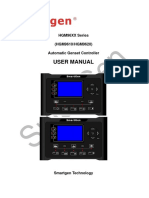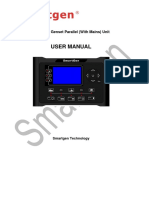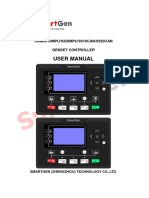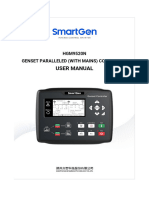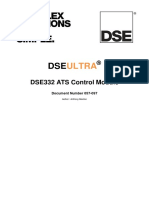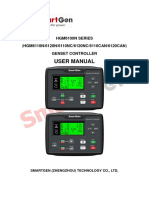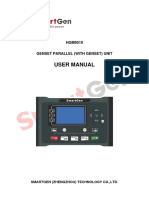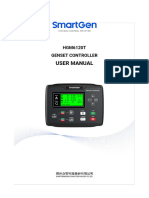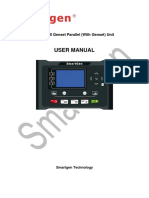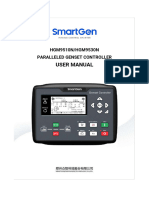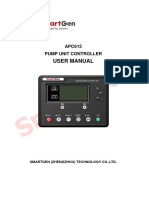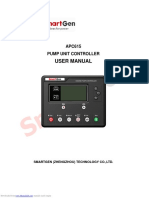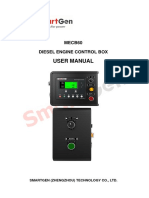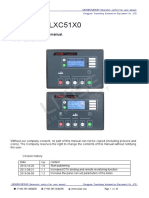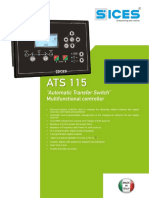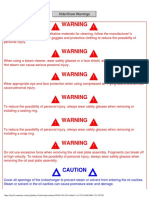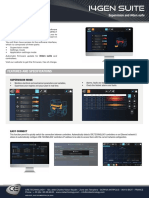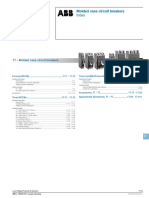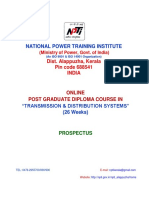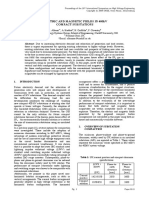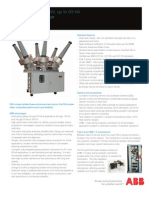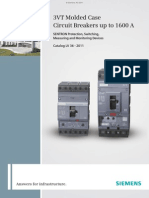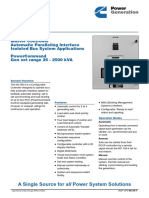HGM9530 Genset Parallel (With Genset) Unit User Manual: Smartgen (Zhengzhou) Technology Co.,Ltd
HGM9530 Genset Parallel (With Genset) Unit User Manual: Smartgen (Zhengzhou) Technology Co.,Ltd
Uploaded by
VinhCopyright:
Available Formats
HGM9530 Genset Parallel (With Genset) Unit User Manual: Smartgen (Zhengzhou) Technology Co.,Ltd
HGM9530 Genset Parallel (With Genset) Unit User Manual: Smartgen (Zhengzhou) Technology Co.,Ltd
Uploaded by
VinhOriginal Title
Copyright
Available Formats
Share this document
Did you find this document useful?
Is this content inappropriate?
Copyright:
Available Formats
HGM9530 Genset Parallel (With Genset) Unit User Manual: Smartgen (Zhengzhou) Technology Co.,Ltd
HGM9530 Genset Parallel (With Genset) Unit User Manual: Smartgen (Zhengzhou) Technology Co.,Ltd
Uploaded by
VinhCopyright:
Available Formats
HGM9530
Genset Parallel (With Genset) Unit
USER MANUAL
SMARTGEN (ZHENGZHOU) TECHNOLOGY CO.,LTD.
Chinese trademark
English trademark
SmartGen ―make your generator smart
SmartGen Technology Co., Ltd
No. 28 Jinsuo Road
Zhengzhou City
P. R. China
Tel: +86-371-67988888
+86-371-67981888
+86-371-67991553
+86-371-67992951
+86-371-67981000 (overseas)
Fax: 0086-371-67992952
Web: http://www.smartgen.com.cn
http://www.smartgen.cn
Email: sales@smartgen.cn
All rights reserved. No part of this publication may be reproduced in any material form (including
photocopying or storing in any medium by electronic means or other) without the written permission of
the copyright holder.
SmartGen Technology reserves the right to change the contents of this document without prior notice.
Software Version
Date Version Content
2014-08-18 1.0 Original release
2014-11-06 1.1 Modify some parameters’ default value;
2015-09-14 1.2 Add expansion module connection description.
2015-10-20 1.3 Add some pictures and modify some description and modules comparison.
1. Add timer settings about gas genset
2016-11-03 1.4
2. Add input and output ports functions.
Symbol Instruction
NOTE Highlights an essential element of a procedure to ensure correctness.
Indicates a procedure or practice, which, if not strictly observed, could result in
CAUTION damage or destruction of equipment.
Indicates a procedure or practice, which could result in injury to personnel or loss of life
WARNING if not followed correctly.
HGM9530 GENSET PARALLEL UNIT USER MANUAL
CONTENTS
1 OVERVIEW ....................................................................................................................................... 5
2 MODULES COMPARISON .............................................................................................................. 6
3 PERFORMANCE AND CHARACTERISTICS .................................................................................. 7
4 SPECIFICATION .............................................................................................................................. 9
5 OPERATION ................................................................................................................................... 10
5.1 INDICATOR LIGHT ................................................................................................................ 10
5.2 PUSHBUTTONS .................................................................................................................... 11
5.3 LCD DISPLAY ........................................................................................................................ 12
5.3.1 MAIN DISPLAY .................................................................................................................. 12
5.3.2 USER MENU AND PARAMETERS SETTING MENU ....................................................... 14
5.4 AUTO START/STOP OPERATION ........................................................................................ 17
5.5 MANUAL START/STOP OPERATION ................................................................................... 19
5.6 SWITCH CONTROL PROCEDURES .................................................................................... 19
5.6.1 MANUAL TRANSFER PROCEDURES ............................................................................. 19
5.6.2 AUTOMATIC CONTROL PROCEDURE ........................................................................... 19
6 PROTECTIONS .............................................................................................................................. 20
6.1 WARNING ALARMS .............................................................................................................. 20
6.2 SHUTDOWN ALARMS .......................................................................................................... 22
6.3 TRIP AND STOP ALARMS .................................................................................................... 24
6.4 TRIP ALARM.......................................................................................................................... 25
7 WIRING CONNECTION .................................................................................................................. 26
8 SCOPES AND DEFINITIONS OF PROGRAMMABLE PARAMETERS ........................................ 29
8.1 CONTENTS AND SCOPES OF PARAMETERS .................................................................... 29
8.2 ENABLE DEFINITION OF PROGRAMMABLE OUTPUT PORTS .......................................... 38
8.2.1 DEFINED PERIOD OUTPUT ............................................................................................. 43
8.2.2 DEFINED COMBINATION OUTPUT ................................................................................. 43
8.3 DEFINED CONTENTS OF PROGRAMMABLE INPUT PORTS (ALL ACTIVE WHEN
CONNECT TO GRAND (B~)).............................................................................................................. 44
8.4 SELECTION OF SENSORS .................................................................................................. 46
8.5 CONDITIONS OF CRANK DINSCONNECT SELECTION ..................................................... 47
9 PARAMETERS SETTING .............................................................................................................. 48
10 SENSORS SETTING ...................................................................................................................... 48
11 COMMISSIONING .......................................................................................................................... 49
11.1 STEP 1: SINGLE UNIT DEBUGGING .................................................................................... 49
11.2 STEP 2: MANUAL PARALLEL OPERATION OFF-LOAD ...................................................... 49
11.3 STEP 3: MANUAL PARALLEL OPERATION ON-LOAD ........................................................ 49
11.4 STEP 4: AUTOMATIC PARALLEL OPERATION ................................................................... 50
12 TYPICAL APPLICATION ............................................................................................................... 51
13 POWER MANAGEMENT MODE .................................................................................................... 54
14 LOAD SHEDDING .......................................................................................................................... 55
15 INSTALLATION .............................................................................................................................. 56
HGM9530 Genset Parallel Unit 2016-11-03 Version 1.4 Page 3 of 65
HGM9530 GENSET PARALLEL UNIT USER MANUAL
16 CONNECTIONS OF CONTROLLER WITH J1939 ENGINE .......................................................... 57
16.1 CUMMINS ISB/ISBE .............................................................................................................. 57
16.2 CUMMINS QSL9 .................................................................................................................... 57
16.3 CUMMINS QSM11(IMPORT) ................................................................................................ 57
16.4 CUMMINS QSX15-CM570 ..................................................................................................... 58
16.5 CUMMINS GCS-MODBUS .................................................................................................... 58
16.6 CUMMINS QSM11 ................................................................................................................. 58
16.7 CUMMINS QSZ13.................................................................................................................. 59
16.8 DETROIT DIESEL DDEC III / IV ............................................................................................. 59
16.9 DEUTZ EMR2 ........................................................................................................................ 59
16.10 JOHN DEERE ........................................................................................................................ 60
16.11 MTU MDEC ............................................................................................................................ 60
16.12 MTU ADEC(SMART MODULE) ............................................................................................. 60
16.13 MTU ADEC(SAM MODULE) .................................................................................................. 60
16.14 PERKINS ............................................................................................................................... 61
16.15 SCANIA.................................................................................................................................. 61
16.16 VOLVO EDC3 ........................................................................................................................ 61
16.17 VOLVO EDC4 ........................................................................................................................ 62
16.18 VOLVO-EMS2........................................................................................................................ 62
16.19 YUCHAI ................................................................................................................................. 62
16.20 WEICHAI................................................................................................................................ 63
17 USB ................................................................................................................................................ 64
18 FAULT FINDING............................................................................................................................. 65
HGM9530 Genset Parallel Unit 2016-11-03 Version 1.4 Page 4 of 65
HGM9530 GENSET PARALLEL UNIT USER MANUAL
1 OVERVIEW
HGM9530 controller is designed for manual/auto parallel system generators with similar or different
capacity. Additionally, it is suitable for single unit constant power output and mains paralleling. It allows
automatic start/stop, parallel running, data measurement, alarm protection as well as remote control,
remote measurement and remote communication function. It fit with LCD display, optional Chinese,
English and other languages interface, and it is reliable and easy to use.
Utilizing the GOV (Engine Speed Governor) and AVR (Automatic Voltage Regulator) control function,
the controller is able to synchronize and share load automatically; it can be used to parallel with other
HGM9530 controller.
HGM9530 controller also monitors the engine, indicating the operational status and fault conditions
accurately. When abnormal condition occurs, it splits bus and shuts down the genset, simultaneously the
exact failure mode information is indicated by the LCD display on the front panel. SAE J1939 interface
enables the controller to communicate with various ECU (ENGINE CONTROL UNIT) which fitted with
J1939 interface.
The powerful 32-bit Microprocessor contained within the module allows for precision parameters
measuring, fixed value adjustment, time setting and set value adjusting and etc..Majority parameters can
be configured from front panel, and all parameters can be configured by USB interface (or RS485) to
adjust via PC. It can be widely used in all types of automatic gen-set control system with compact
structure, advanced circuits, simple connections and high reliability. The controller can monitor genset
cylinder temperature and venting temperature via expansion analog input module (especially suitable for
gas genset automatic parallel system).
HGM9530 Genset Parallel Unit 2016-11-03 Version 1.4 Page 5 of 65
HGM9530 GENSET PARALLEL UNIT USER MANUAL
2 MODULES COMPARISON
Item HGM9510 HGM9520 HGM9530 HGM9540
LCD Dimension 4.3”
Pixel 480 x 272
AMF ● ●
BUS Monitoring ● ●
Parallel connection ● ● ● ●
Digital input expansion ● ● ● ●
Digital output expansion ● ● ● ●
Analog input expansion ● ●
Input Port 7 8 7 8
Output Port 8 8 8 8
Sensor Number 5 5 5 5
Neutral (Earth) current
Schedule function ● ● ● ●
RS485 ● ● ● ●
GSM
J1939 ● ● ● ●
USB ● ● ● ●
LINK
Real-time clock ● ● ● ●
Event log ● ● ● ●
NOTE:
(1) Two of the outputs are fixed: start output and fuel output.
(2)HGM9530’s analog sensors are composed by 3 fixed sensors (temperature, pressure, level) and 2
configurable sensors.
NOTE: The features of HGM9210/HGM9220/HGM9310/HGM9320/HGM9410/
HGM9420/HGM9520/HGM9610/HGM9620 controllers mentioned in this document may change, please
check the corresponding user manual for accurate information.
HGM9530 Genset Parallel Unit 2016-11-03 Version 1.4 Page 6 of 65
HGM9530 GENSET PARALLEL UNIT USER MANUAL
3 PERFORMANCE AND CHARACTERISTICS
With ARM-based 32-bit SCM, high integration of hardware and more reliable;
480x272 LCD with backlight, multilingual interface (including English, Chinese or other languages)
which can be chosen at the site, making commissioning convenient for factory personnel;
Improved LCD wear-resistance and scratch resistance due to hard screen acrylic;
Silicon panel and pushbuttons for better operation in high/low temperature environment;
RS485 communication port enable remote control, remote measuring, remote communication via
ModBus protocol.
Fitted with ECU CANBUS port and can communicate with J1939 genset. Not only can you
monitoring frequently-used data (such as water temperature, oil pressure, engine speed, fuel
consumption and so on) of ECU machine, but also control start, stop, raising speed and speed
droop via CANBUS port. The genset also can connect to expansion modules: digital input module
DIN16, digital output module DOUT16A and analog input module AIN24 (can monitor genset
cylinder temperature and venting temperature).
Suitable for 3-phase 4-wire, 3-phase 3-wire, single phase 2-wire, and 2-phase 3-wire systems with
voltage 120/240V and frequency 50/60Hz;
Collects and shows 3-phase voltage, current, power parameter and frequency of Bus/mains.
For Bus, controller has loss of phase and phase sequence wrong detection functions; For generator,
controller has over voltage, under voltage, over frequency, under frequency, over current, over
power, reverse power, loss of phase, phase sequence wrong detection functions;
Synchronization parameters:Voltage Difference Between Bus and Mains, Frequency Difference
Between Bus and Mains, Phase Difference Between Bus and mains;
Multiple running modes in auto state: with load running, off load running, demand parallel running;
Ramp on and ramp off function;
3 fixed sensors (temperature, oil pressure and liquid level);
2 configurable sensors can be set as sensor of temperature, oil pressure or fuel level;
More kinds of curves of temperature, oil pressure, fuel level can be used directly and users can
define the sensor curves by themselves;
Precision measure and display parameters about Engine,
Temp. (WT) °C/°F both be displayed
Oil pressure (OP) kPa/psi/bar all be displayed
Fuel level (FL) %(unit)
Speed (SPD) r/min(unit)
Battery Voltage (VB) V (unit)
Charger Voltage (VD) V (unit)
Hour count (HC) can accumulate Max. 65535 hours.
Start times can accumulate Max. 65535 times
HGM9530 Genset Parallel Unit 2016-11-03 Version 1.4 Page 7 of 65
HGM9530 GENSET PARALLEL UNIT USER MANUAL
Protection: automatic start/stop of the gen-set, ATS(Auto Transfer Switch) control with perfect fault
indication and protection function;
All output ports are relay output;
Parameter setting: parameters can be modified and stored in internal EEPROM memory and cannot
be lost even in case of power outage; most of them can be adjusted using front panel of the
controller and all of them can be modified using PC via USB or RS485 ports;
Multiple crank disconnect conditions (rotate speed, oil pressure, generator frequency) are optional;
Widely power supply range DC(8~35)V, suitable to different starting battery voltage environment;
Event log, real-time clock, scheduled start & stop generator (can be set as start genset once a
day/week/month whether with load or not);
Accumulative total run time and total electric energy of A and B. Users can reset it as 0 and
re-accumulative the value which make convenience to users to count the total value as their wish.
Can control engine heater, cooler and fuel pump.
With maintenance function. Actions (warning, trip and stop, shutdown) can be set when
maintenance time out;
All parameters used digital adjustment, instead of conventional analog modulation with normal
potentiometer, more reliability and stability;
IP55 waterproofness level can be achieved with the help of rubber-ring gasket between shell and
control panel.
Metal fixing clips enable perfect in high temperature environment;
Modular design, self-extinguishing ABS plastic shell, pluggable terminal, built-in mounting,compact
structure with easy installation;
HGM9530 Genset Parallel Unit 2016-11-03 Version 1.4 Page 8 of 65
HGM9530 GENSET PARALLEL UNIT USER MANUAL
4 SPECIFICATION
Parameter Details
Working Voltage DC8. 0V to 35. 0V, uninterruptible power supply
Overall Consumption <4W (Standby mode: ≤2W)
AC Input:
3 Phase 4 Wire AC 15V - 360V (ph-N)
3 Phase 3 Wire AC 30V - 620V (ph- ph)
Single Phase 2 Wire AC 15V - 360V (ph-N)
2 Phase 3 Wire AC 15V - 360V (ph-N)
Alternator Frequency 50Hz/60Hz
Speed Sensor Voltage 1. 0 V to 24 V (RMS)
Speed Sensor Frequency Maximum 10,000 Hz
Start Relay Output 16A DC28V power supply output
Fuel Relay Output 16A DC28V power supply output
Flexible Relay Output 1 7A DC28V power supply output
Flexible Relay Output 2 7A DC28V power supply output
Flexible Relay Output 3 7A DC28V power supply output
Flexible Relay Output 4 7A 250VAC passive output
Flexible Relay Output 5 7A 250VAC passive output
Flexible Relay Output 6 7A 250VAC passive output
Case Dimensions 266mm x 182mm x 45mm
Panel Cutout 214mm x 160mm
CT Secondary Current Rated 5A
Working Conditions Temperature: (-25~+70)°C Humidity: (20~93)%RH
Storage Conditions Temperature:(-25~+70)°C
Protection Level IP55 Gasket
Apply AC2.2kV voltage between high voltage terminal and low voltage
Insulation Intensity
terminal. The leakage current is not more than 3mA within 1min.
Weight 0.93kg
HGM9530 Genset Parallel Unit 2016-11-03 Version 1.4 Page 9 of 65
HGM9530 GENSET PARALLEL UNIT USER MANUAL
5 OPERATION
5.1 INDICATOR LIGHT
NOTE: Selected light indicators description:
Warning indicator and Alarm indicator:
Alarm Type Warning Indicator Alarm Indicator
Warning Slow flashing Slow flashing
Trip Alarm Slow flashing Slow flashing
Shutdown Alarm Off Fast flashing
Trip and Stop Alarm Off Fast flashing
Running indicator: illuminated from crank disconnect to ETS while off during other periods.
Genenerator normal light:It is light on when generator is normal; flashing when generator state is
abnormal; off when there is no generator power.
HGM9530 Genset Parallel Unit 2016-11-03 Version 1.4 Page 10 of 65
HGM9530 GENSET PARALLEL UNIT USER MANUAL
5.2 PUSHBUTTONS
Icons Keys Description
Stop running generator in Auto/Manual mode; Lamp test (press
Stop at least 3 seconds); Reset alarm in stop mode; During stopping
process, press this button again to stop generator immediately.
Start Start genset in Manual mode.
Manual Mode Press this key and controller enters in Manual mode.
Auto Mode Press this key and controller enters in Auto mode.
Alarming sound off; If trip alarm occurs, pressing the button at
Mute/Reset Alarm
least 3 seconds can reset this alarm.
Close Close breaker in manual mode.
Open Open breaker in manual mode.
1) Screen scroll;
Up/Increase
2) Up cursor and increase value in setting menu.
1) Screen scroll;
Down/Decrease
2) Down cursor and decrease value in setting menu.
1) Screen scroll;
Left
2) Left move cursor in setting menu.
1) Screen scroll;
Right
2) Right move cursor in setting menu.
Set/Confirm Select viewing area.
1)Return to main menu;
Exit
2) Return to previous menu in setting menu.
NOTE: Press and simultaneously in manual mode will force generator to crank.
Successful start will not be judged according to crank disconnect conditions, operator will have to crank
the starter motor manually; when operator decides that the engine has fired, he/she should release the
button and start output will be deactivated, safety on delay will be initiated.
WARNING: Default password is 00318, user can change it in case of others change the advanced
parameters setting. Please clearly remember the password after changing. If you forget it, please
contact SmartGen services and send all information in the controller page of “ABOUT” to us.
HGM9530 Genset Parallel Unit 2016-11-03 Version 1.4 Page 11 of 65
HGM9530 GENSET PARALLEL UNIT USER MANUAL
5.3 LCD DISPLAY
5.3.1 MAIN DISPLAY
Main screen show pages; use to scroll the pages and to scroll the screen.
Main Screen, including as below,
Gen: voltage, frequency, current, active power, reactive power
Bus: voltage, frequency
Engine: speed, temperature, oil pressure
Some status
Status, including as below,
Status of genset and ATS
Engine, including as below,
Engine speed, engine temperature, engine oil pressure, fuel level, flexible sensor 1, flexible sensor 2,
battery voltage, charger voltage, engine accumulated run, accumulated start times.
NOTE: If connected with J1939 engine via CANBUS port, this page also includes: coolant pressure,
coolant level, fuel temperature, fuel pressure, inlet temperature, exhaust temperature, turbo pressure,
total fuel consumption and so on. (Different engine with different parameters)
Generator, including as below,
Phase voltage, line voltage, frequency, phase sequence, current, Active Power(positive and negative),
total active power (positive and negative), Reactive Power(positive and negative), total reactive power
(positive and negative), Apparent Power, total apparent power, Power Factor(positive and negative),
average power factor (positive and negative), accumulated energy (kWh, kVarh, kVAh), multi power,
earth current, negative sequence current.
NOTE: Power factor shows as following,
Remark:
P stands for active power
Q stands for inactive power
Power Active
Conditions Reactive power Remark
factor power
COS>0L P>0,Q>0 Input Input Load is inductive resistance.
COS>0C P>0,Q<0 Input Output Load is capacitance resistance.
COS<0L P<0,Q>0 Output Input Load is equal to one under excitation generator.
COS<0C P<0,Q<0 Output Output Load is equal to one over excitation generator.
HGM9530 Genset Parallel Unit 2016-11-03 Version 1.4 Page 12 of 65
HGM9530 GENSET PARALLEL UNIT USER MANUAL
Note:
1. Input active power, generator send active power to load.
2. Output active power, load supply electricity to generator.
3. Input reactive power, generator send reactive power to load.
4. Output reactive power, load send reactive power to generator.
Bus, including as below,
Phase voltage, line voltage, frequency, phase sequence
SNYC, including as below,
Volt difference, freq difference, angle difference, active power percentage, target active power
percentage, reactive power percentage, target reactive power percentage, GOV percentage, AVR
percentage and MSC status
Alarm:
NOTE: For ECU alarms and shutdown alarms, if the alarm information is displayed, check engine
according to it, otherwise, please check the generator manual according to SPN alarm code.
Event log
Make records about all start/stop events (shutdown alarm, trip and stop alarm, manual /auto start or stop)
and the real time when alarm occurs.
Others, including,
Time and Date, maintenance due, input/output ports status.
About, including,
Issue time of software and hardware version, product PD number.
HGM9530 Genset Parallel Unit 2016-11-03 Version 1.4 Page 13 of 65
HGM9530 GENSET PARALLEL UNIT USER MANUAL
5.3.2 USER MENU AND PARAMETERS SETTING MENU
Press key for more than 3s to enter into user manual.
Parameter
After entering the correct password (factory default password is 00318) you can enter parameter
settings screen.
Language
Selectable Chinese, English and others (default: Espanol)
Commissioning
On load, off load or custom commissioning can be chosen. Custom commissioning can configure on
load or not during commissioning, when to commissioning and select the mode after commissioning
(manual mode, auto mode and stop mode).
Clear users’ accumulation
Can clear total run time A and B, total electric energy A and B.
Parameter setting including as following,
Timer settings
Engine settings
Generator settings
Load settings
Breaker settings
Analog sensor settings
Switch input port settings
output port settings
Module settings
Scheduling and maintenance settings
Synchronization settings
Expansion module settings
Return >Start Delay
Timers > >Return Delay Interface 1: Use to scroll settings,
Engine >Preheat Delay
Generator >Cranking Time to enter settings (Interface 2), to exit settings
Load >Crank Rest Time menu.
Breaker >Safety On Time
Temp. Sensor >Start Idle Time
OP Sensor >Warming Up Time
Level Sensor >Cooling Time
Config Sensor 1 >Stop Idle Time
Config Sensor 2 >ETS Hold Time
HGM9530 Genset Parallel Unit 2016-11-03 Version 1.4 Page 14 of 65
HGM9530 GENSET PARALLEL UNIT USER MANUAL
Return > Start Delay
Timers > > Return Delay Interface 2: Use to scroll settings, to
Engine > Preheat Delay
Generator > Cranking Time enter settings (Interface 4), to return to
Load > Crank Rest Time previous menu. (Interface 1)
Breaker > Safety On Time
Temp. Sensor > Start Idle Time
OP Sensor > Warming Up Time
Level Sensor > Cooling Time
Config Sensor 1 Config > Stop Idle Time
Sensor 2 > ETS Hold Time
Return > Start Delay
Timers > > Return Delay Interface 3: Use to scroll settings, to
Engine > Preheat Delay
Generator enter settings (Interface 4), to return to
> Cranking Time
Load > Crank Rest Time previous menu. (Interface 1)
Breaker > Safety On Time
Temp. Sensor > Start Idle Time
OP Sensor >Warming Up Time
Level Sensor > Cooling Time
Config Sensor 1 Config > Stop Idle Time
Sensor 2 > ETS Hold Time
> Start Delay
> Return Delay 00008 Interface 4: Press to enter settings (Interface
> Preheat Delay
5), to return to previous menu. (Interface 6).
> Cranking Time
>Crank Rest Time
> Safety On Time
> Start Idle Time
> Warming Up Time
> Cooling Time
> Stop Idle Time
> ETS Hold Time
> Start Delay
> Return Delay 00008 Interface 5: Press to change cursor position,
> Preheat Delay
> Cranking Time are used for changing cursor value,
HGM9530 Genset Parallel Unit 2016-11-03 Version 1.4 Page 15 of 65
HGM9530 GENSET PARALLEL UNIT USER MANUAL
> Crank Rest Time
> Safety On Time Confirm setting (Interface 4), exit setting
> Start Idle Time (Interface 4).
> Warming Up Time
> Cooling Time
> Stop Idle Time
> ETS Hold Time
> Start Delay Interface 6: are used for changing the
> Return Delay 00008
> Preheat Delay setting contents. Confirm setting (Interface 4),
> Cranking Time
> Crank Rest Time to return to previous menu. (Interface 1).
> Safety On Time
> Start Idle Time
> Warming Up Time
> Cooling Time
> Stop Idle Time
> ETS Hold Time
>Wait For Stop
NOTE: Pressing can exit setting directly during setting.
HGM9530 Genset Parallel Unit 2016-11-03 Version 1.4 Page 16 of 65
HGM9530 GENSET PARALLEL UNIT USER MANUAL
5.4 AUTO START/STOP OPERATION
Auto mode is selected by pressing the button; a LED besides the button will illuminate to confirm
the operation.
Automatic Start Sequence:
1. When “Remote Start” is active, “Start Delay” timer is initiated;
2. “Start Delay” countdown will be displayed on LCD;
3. When start delay is over, preheat relay energizes (if configured), “preheat delay XX s” information
will be displayed on LCD;
4. After the above delay, the Fuel Relay (if configured) is energized, and then one second later, the
Start Relay is engaged. The engine is cranked for a pre-set time. If the engine fails to fire during this
cranking attempt then the fuel relay and start relay are disengaged for the pre-set rest period; “crank
rest time” begins and wait for the next crank attempt.
5. Should this start sequence continue beyond the set number of attempts, the start sequence will be
terminated, the first line of LCD display will be highlighted with black and Fail to Start fault will be
displayed.
6. In case of successful crank attempt, the “Safety On” timer is activated, allowing Low Oil Pressure,
High Temperature, Under speed and Charge Alternator Failure inputs to stabilise without triggering
the fault. As soon as this delay is over, “start idle” delay is initiated (if configured).
7. During “start idle” delay, under speed, under frequency, under voltage alarms are inhibited. When
this delay is over, “warming up” delay is initiated (if configured).
8. In the case of a single generator system, after the “warming up” delay, if generator status is normal,
its indicator will be illuminated. If generator voltage and frequency have reached on-load
requirements, then the generator close relay will be energized; genset will take load; generator
power indicator will illuminate and generator will enter into Normal Running status. If voltage or
frequency is abnormal, the controller will initiate shutdown alarm (alarm information will be displayed
on LCD).
9. In case of running in parallel, after the warming up delay:
a) If bus has no voltage, then the controller will send a closing signal to other waiting parallel gensets
and generator close relay will activate, this prevents other sets in the system from attempting to
close their own breakers at the same time.
b) If bus has voltage or other gensets are already closed, the controller will adjust speed and voltage
through GOV and AVR to synchronize the gensets to the bus; when synchronism requirements has
been achieved, breaker close signal will be initiated and the genset will be paralleled with the bus.
Once they are paralleled, the controller will control the generator to gradually accelerate and share
load with other paralleled gensets.
HGM9530 Genset Parallel Unit 2016-11-03 Version 1.4 Page 17 of 65
HGM9530 GENSET PARALLEL UNIT USER MANUAL
Note: When started via “Remote Start (off Load)” input, same procedures as above but generator
close relay deactivated, moreover, genset off load. When started via “Remote Start (Demand)” input,the
genset will start, synchronization, parallel and load sharing automatically according to the pre-set priority
order.
Automatic Stop Sequence,
1) When the “Remote Start” signal is removed, the Stop Delay is initiated.
2) Once this “stop delay” has expired, the module will ramp the load from the generator to remaining
set. The Generator Breaker will open and the “Cooling Delay” is then initiated. Should the Remote
Start signal be re-activated during the cooling down period, the set will return parallel status. Once
the “Cooling Delay” expires, the “Stop Idle” delay is initiated.
3) During “Stop Idle” Delay (if configured), idle relay is energized.
4) “ETS Solenoid Hold” begins, ETS relay is energized while fuel relay is de-energized, complete stop
is detected automatically.
5) "Fail to Stop Delay" begins, complete stop is detected automatically.
6) When generator is stop completely, “After stop” delay will be initiated. Otherwise, fail to stop alarm is
initiated and the corresponding alarm information is displayed on LCD. ( If generator is stop
successfully after “fail to stop” alarm has initiated, “After stop” delay will be initiated and the alarm
will be removed)
7) Generator is placed into its standby mode after its “After stop” delay.
HGM9530 Genset Parallel Unit 2016-11-03 Version 1.4 Page 18 of 65
HGM9530 GENSET PARALLEL UNIT USER MANUAL
5.5 MANUAL START/STOP OPERATION
1. Manual mode is selected by pressing the button; a LED besides the button will illuminate to
confirm the operation; then press button to start the gen-set; can detect crank disconnect
condition and generator accelerates to high-speed running automatically. With high temperature,
low oil pressure, over speed and abnormal voltage during generator running, controller can protect
genset to stop quickly (please refer to No.3~9 of Automatic Start Sequence for detail procedures).
2. MANUAL STOP: Press can shuts down the running generators. (Please refer to No.2~7 of
Automatic Start Sequence for detail procedures).
NOTE: In “manual mode”, the procedures of ATS please refer to Switch Control Procedure of
generator in this manual.
5.6 SWITCH CONTROL PROCEDURES
5.6.1 MANUAL TRANSFER PROCEDURES
When controller is in Manual mode, the switch control procedures will start through manual transfer
procedures. Users can control the loading transfer of ATS via pressing button to switch on or off.
Closing Operation:During genset normal running, press if generator voltage and frequency have
reached on-load requirements
1) In case of single unit running, generator closing relay outputs;
2) In case of running in parallel:
a) If bus has no voltage, then the controller will send a closing signal to other waiting parallel gensets
and generator close relay will activate, this prevents other sets in the system from attempting to
close their own breakers at the same time.
b) If bus has voltage or other gensets are already closed, the controller will adjust speed and voltage
through GOV and AVR to synchronize the gensets to the bus; when synchronism requirements has
been achieved, breaker close signal will be initiated and the genset will be paralleled to the bus.
Once they are paralleled, the controller will control the generator to gradually accelerate and share
load with other paralleled gensets.
Opening operation:Press ,
1) In case of single unit running, the controller sends open breaker signal.
2) During parallel operation, if button is pressed, first of all, the controller will transfer load to
other generators, and only then send an opening signal.
5.6.2 AUTOMATIC CONTROL PROCEDURE
When controller is in auto mode, the switch control procedure is automatic control procedure.
Note: The auxiliary close input should be configured necessarily and make sure the connection is
correct.
HGM9530 Genset Parallel Unit 2016-11-03 Version 1.4 Page 19 of 65
HGM9530 GENSET PARALLEL UNIT USER MANUAL
6 PROTECTIONS
6.1 WARNING ALARMS
Warnings are not shutdown alarms and do not affect the operation of the gen-set. Warning alarms does
not lead to shutdown. Warning alarms types are as follows:
No Type Description
When the controller detects that the engine speed has exceeded the
1 Over Speed
pre-set value, it will initiate a warning alarm.
When the controller detects that the engine speed has fallen below the
2 Under Speed
pre-set value, it will initiate a warning alarm.
When the controller detects that the engine speed is 0 and the action
3 Loss of Speed Signal
select “Warn”, it will initiate a warning alarm.
When the controller detects that the genset frequency has exceeded the
4 Gen Over Frequency
pre-set value, it will initiate a warning alarm.
When the controller detects that the genset frequency has fallen below
5 Gen Under Frequency
the pre-set value, it will initiate a warning alarm.
When the controller detects that the generator voltage has exceeded the
6 Gen Over Voltage
pre-set value, the controller will initiate a warning alarm.
When the controller detects that the genset voltage has fallen below the
7 Genset Under Voltage
pre-set value, it will initiate a warning alarm.
When the controller detects that the genset current has exceeded the
8 Gen Over Current pre-set value and the action select “Warn”, it will initiate a warning
alarm.
After “fail to stop” delay, if gen-set does not stop completely, it will
9 Fail To Stop
initiate a warning alarm.
Charge Alternator When the controller detects that charger voltage has fallen below the
10
Failure pre-set value, it will initiate a warning alarm.
When the controller detects that start battery voltage has fallen below
11 Battery Under Volt
the pre-set value, it will initiate a warning alarm.
When the controller detects that start battery voltage has exceeded the
12 Battery Over Volt
pre-set value, it will initiate a warning alarm.
When count down time is 0 and the action select “Warn”, it will initiate a
13 Maintenance Due
warning alarm.
If reverse power detection is enabled, when the controller detects that
14 Reverse Power the reverse power value (power is negative) has fallen below the pre-set
value and the action select “Warn”, it will initiate a warning alarm.
If over power detection is enabled, when the controller detects that the
15 Over Power over power value (power is positive) has exceeded the pre-set value
and the action select “Warn”, it will initiate a warning alarm.
If an error message is received from ECU via J1939, it will initiate a
16 ECU Warn
warning alarm.
If loss of phase detection is enabled, When controller detects the
17 Gen Loss of Phase
generator loss phase, it will initiate a warning alarm.
Gen Phase Sequence When the controller detects a phase rotation error, it will initiate a
18
Wrong warning alarm.
When the controller detects that the breaker close or open failure
19 Switch Fail Warn
occurs, and the action select “Warn”, it will initiate a warning alarm.
HGM9530 Genset Parallel Unit 2016-11-03 Version 1.4 Page 20 of 65
HGM9530 GENSET PARALLEL UNIT USER MANUAL
No Type Description
Temperature Sensor When the controller detects that the temperature sensor is open circuit
20
Open Circuit and the action select “Warn”, it will initiate a warning alarm.
When the controller detects that engine temperature has exceeded the
21 High Temperature
pre-set value, it will initiate a warning alarm.
When the controller detects that engine temperature has fallen below
22 Low Temperature
the pre-set value, it will initiate a warning alarm.
Oil Pressure Open When the controller detects that the oil pressure sensor is open circuit
23
Circuit and the action select “Warn”, it will initiate a warning alarm.
When the controller detects that the oil pressure has fallen below the
24 Low Oil Pressure
pre-set value, it will initiate a warning alarm.
Level Sensor Open When the controller detects that the level sensor is open circuit and the
25
Circuit action select “Warn”, it will initiate a warning alarm.
When the controller detects that the fuel level has fallen below the
26 Low Fuel Level
pre-set value, it will initiate a warning alarm.
Flexible Sensor 1 Open When the controller detects that the flexible sensor 1 is open circuit and
27
Circuit the action select “Warn”, it will initiate a warning alarm.
When the controller detects that the sensor 1 value has exceeded the
28 Flexible Sensor 1 High
pre-set value, it will initiate a warning alarm.
When the controller detects that the sensor 1 value has fallen below the
29 Flexible Sensor 1 Low
pre-set value, it will initiate a warning alarm.
Flexible Sensor 2 Open When the controller detects that the flexible sensor 2 is open circuit and
30
Circuit the action select “Warn”, it will initiate a warning alarm.
When the controller detects that the sensor 2 value has exceeded the
31 Flexible Sensor 2 High
pre-set value, it will initiate a warning alarm.
When the controller detects that the sensor 2 value has fallen below the
32 Flexible Sensor 2 Low
pre-set value, it will initiate a warning alarm.
When digit input port is set as warning and the alarm is active, it will
33 Digital Input
initiate a warning alarm.
If earth fault detection is enabled, when the controller detects that the
34 Earth Fault earth fault current has exceeded the pre-set value and the action select
“Warn”, it will initiate a warning alarm.
Negative Sequence When the controller detects the imbalance current has exceeded the
35
Current pre-set value and the action select “Warn” it will initiate a warning alarm.
When the controller does not detect synchronization signal within the
36 Fail to sync
pre-set synchronization time, it will initiate a warning alarm.
When the controller detects fewer modules on the MSC link than the
minimum number configured in the unit, it will initiate a warning alarm.
37 MSC Too Few Sets There are 2 possible reasons: a) Communication line between the
controllers disconnects, which interrupts communication.
b) Other parallel gen-sets controllers have not been powered on.
When the controller detects that the genset negative reactive power has
38 Loss of Excitation
exceeded the pre-set value, it will initiate a warning alarm.
HGM9530 Genset Parallel Unit 2016-11-03 Version 1.4 Page 21 of 65
HGM9530 GENSET PARALLEL UNIT USER MANUAL
6.2 SHUTDOWN ALARMS
When controller detects shutdown alarm, it will send signal to open breaker and shuts down generator.
Shutdown alarms as following:
No Type Description
When the controller detects an emergency stop alarm signal, it will
1 Emergency Stop
initiate a shutdown alarm.
When the controller detects that the generator speed has exceeded the
2 Over Speed
pre-set value, it will initiate a shutdown alarm.
When the controller detects that the generator speed has fallen below
3 Under Speed
the pre-set value, it will initiate a shutdown alarm.
When the controller detects that the engine speed is 0 and the action
4 Loss of Speed Signal
select “Shutdown”, it will initiate a shutdown alarm.
When the controller detects that the genset frequency has exceeded the
5 Gen Over Frequency
pre-set value, it will initiate a shutdown alarm.
Gen Under When the controller detects that the genset frequency has fallen below
6
Frequency the pre-set value, it will initiate a shutdown alarm.
When the controller detects that the generator voltage has exceeded the
7 Gen Over Voltage
pre-set value, the controller will initiate a shutdown alarm.
When the controller detects that the genset voltage has fallen below the
8 Genset Under Voltage
pre-set value, it will initiate a shutdown alarm.
If the engine does not fire after the pre-set number of attempts, it will
9 Fail To Stop
initiate a shutdown alarm.
When the controller detects that the genset current has exceeded the
10 Gen Over Current pre-set value and the action select “Shutdown”, it will initiate a shutdown
alarm.
When count down time is 0 and the action select “Shutdown”, it will
11 Maintenance Due
initiate a shutdown alarm.
If an error message is received from ECU via J1939, it will initiate a
12 ECU Shutdown
shutdown alarm.
If the module does not detect the ECU data, it will initiate a shutdown
13 ECU Fail
alarm.
If reverse power detection is enabled, when the controller detects that
14 Reverse Power the reverse power value (power is negative) has fallen below the pre-set
value and the action select “Shutdown”, it will initiate a shutdown alarm.
If over power detection is enabled, when the controller detects that the
15 Over Power over power value (power is positive) has exceeded the pre-set value
and the action select “Shutdown”, it will initiate a shutdown alarm.
Temperature Sensor When the controller detects that the temperature sensor is open circuit
16
Open Circuit and the action select “Shutdown”, it will initiate a shutdown alarm.
When the controller detects that engine temperature has exceeded the
17 High Temperature
pre-set value, it will initiate a shutdown alarm.
Oil Pressure Open When the controller detects that the oil pressure sensor is open circuit
18
Circuit and the action select “Shutdown”, it will initiate a shutdown alarm.
When the controller detects that the oil pressure has fallen below the
19 Low Oil Pressure
pre-set value, it will initiate a shutdown alarm.
HGM9530 Genset Parallel Unit 2016-11-03 Version 1.4 Page 22 of 65
HGM9530 GENSET PARALLEL UNIT USER MANUAL
No Type Description
Level Sensor Open When the controller detects that the level sensor is open circuit and the
20
Circuit action select “Shutdown”, it will initiate a shutdown alarm.
Flexible Sensor 1 Open When the controller detects that the flexible sensor 1 is open circuit and
21
Circuit the action select “Shutdown”, it will initiate a shutdown alarm.
When the controller detects that the sensor 1 value has exceeded the
22 Flexible Sensor 1 High
pre-set value, it will initiate a shutdown alarm.
When the controller detects that the sensor 1 value has fallen below the
23 Flexible Sensor 1 Low
pre-set value, it will initiate a shutdown alarm.
Flexible Sensor 2 Open When the controller detects that the flexible sensor 2 is open circuit and
24
Circuit the action select “Shutdown”, it will initiate a shutdown alarm.
When the controller detects that the sensor 2 value has exceeded the
25 Flexible Sensor 2 High
pre-set value, it will initiate a shutdown alarm.
When the controller detects that the sensor 2 value has fallen below the
26 Flexible Sensor 2 Low
pre-set value, it will initiate a shutdown alarm.
When digit input port is set as shutdown and the alarm is active, it will
27 Digital Input
initiate a shutdown alarm.
If earth fault detection is enabled, when the controller detects that the
28 Earth Fault earth fault current has exceeded the pre-set value and the action select
“Shutdown”, it will initiate a shutdown alarm.
When the controller detects the imbalance current has exceeded the
Negative Sequence
29 pre-set value and the action select “Shutdown” it will initiate a shutdown
Current
alarm.
When the controller detects fewer modules on the MSC link than the
minimum number configured in the unit, it will initiate a shutdown alarm.
30 MSC Too Few Sets There are 2 possible reasons: a) Communication line between the
controllers disconnects, which interrupts communication.
b) Other parallel gen-sets controllers have not been powered on.
When the controller detects the same ID on the MSC Bus, it will initiate a
31 MSC ID Error
shutdown alarm.
Gen Phase Sequence When the controller detects a phase rotation error, it will initiate a
32
Wrong shutdown alarm.
Bus Phase Sequence When the controller detects a bus phase rotation error, it will initiate a
33
Wrong shutdown alarm.
When the controller detects the voltage difference between generator
34 Bus Error
and bus, it will initiate a shutdown alarm.
When the controller detects that the genset negative reactive power has
35 Loss of Excitation
exceeded the pre-set value, it will initiate a shutdown alarm.
Controller initiate shutdown alarm after digital input port been configured
36 Low Coolant Level
as low coolant level shutdown ( is active).
Controller initiate shutdown alarm after digital input port been configured
37 Detonation Shutdown
as detonation shutdown ( is active).
Controller initiate shutdown alarm after digital input port been configured
38 Gas Leak Shutdown
as gas leakage shutdown ( is active).
HGM9530 Genset Parallel Unit 2016-11-03 Version 1.4 Page 23 of 65
HGM9530 GENSET PARALLEL UNIT USER MANUAL
6.3 TRIP AND STOP ALARMS
On initiation of the trip and stop condition the controller will de-energize the ‘Close Generator’ Output to
remove the load from the generator. Once this has occurred the controller will start the Cooling delay
and allow the engine to cool before shutting down the engine.
No Type Description
When the controller detects that the genset current has exceeded the
1 Gen Over Current pre-set value and the action select “Trip and Stop”, it will initiate a trip
and stop alarm.
When count down time is 0 and the action select “Trip and Stop”, it will
2 Maintenance Due
initiate a trip and stop alarm.
If reverse power detection is enabled, when the controller detects that
the reverse power value (power is negative) has fallen below the pre-set
3 Reverse Power
value and the action select “Trip and Stop”, it will initiate a trip and stop
alarm.
If over power detection is enabled, when the controller detects that the
4 Over Power over power value (power is positive) has exceeded the pre-set value
and the action select “Trip and Stop”, it will initiate a trip and stop alarm.
When digit input port is set as “Trip and Stop” and the alarm is active, it
5 Digital Input
will initiate a trip and stop alarm.
If earth fault detection is enabled, when the controller detects that the
6 Earth Fault earth fault current has exceeded the pre-set value and the action select
“Trip and Stop”, it will initiate a trip and stop alarm.
When the controller detects the imbalance current has exceeded the
Negative Sequence
7 pre-set value and the action select “Trip and Stop”, it will initiate a trip
Current
and stop alarm.
When the controller detects that the genset negative reactive power has
8 Loss of Excitation
exceeded the pre-set value, it will initiate a trip and stop alarm.
When the controller detects that the mains frequency has exceeded the
9 Mains Over Freq
pre-set value, it will initiate a trip and stop alarm.
When the controller detects that the mains frequency has fallen below
10 Mains Under Freq
the pre-set value, it will initiate a trip and stop alarm.
When the controller detects that the mains voltage has exceeded the
11 Mains Over Voltage
pre-set value, it will initiate a trip and stop alarm.
When the controller detects that the mains voltage has fallen below the
12 Mains Under Voltage
pre-set value, it will initiate a trip and stop alarm.
When the controller detects that the ROCOF (rate of change of
13 Mains ROCOF frequency) has exceeded the pre-set value, it will initiate a trip and stop
alarm.
When the controller detects that vector shift value has exceeded the
14 Mains Vector Shift
pre-set value, it will initiate a trip and stop alarm.
HGM9530 Genset Parallel Unit 2016-11-03 Version 1.4 Page 24 of 65
HGM9530 GENSET PARALLEL UNIT USER MANUAL
6.4 TRIP ALARM
On initiation of the trip condition the controller will de-energize the ‘Close Generator’ Output without stop
the generator.
Trip alarm as following,
No Type Description
When the controller detects that the genset current has exceeded the
1 Gen Over Current
pre-set value and the action select “Trip”, it will initiate a trip alarm.
If reverse power detection is enabled, when the controller detects that
2 Reverse Power the reverse power value (power is negative) has fallen below the pre-set
value and the action select “Trip”, it will initiate a trip alarm.
If over power detection is enabled, when the controller detects that the
3 Over Power over power value (power is positive) has exceeded the pre-set value
and the action select “Trip”, it will initiate a trip alarm.
When digit input port is set as “Trip” and the alarm is active, it will initiate
4 Digital Input
a trip alarm.
If earth fault detection is enabled, when the controller detects that the
5 Earth Fault earth fault current has exceeded the pre-set value and the action select
“Trip”, it will initiate a trip alarm.
Negative Sequence When the controller detects the imbalance current has exceeded the
6
Current pre-set value and the action select “Trip”, it will initiate a trip alarm.
When the controller detects that the genset negative reactive power has
7 Loss of Excitation
exceeded the pre-set value, it will initiate a trip alarm.
HGM9530 Genset Parallel Unit 2016-11-03 Version 1.4 Page 25 of 65
HGM9530 GENSET PARALLEL UNIT USER MANUAL
7 WIRING CONNECTION
HGM9530 controller’s back panel as following:
Description of terminal connection:
No. Functions Cable Size Remark
2
1 B- 2.5mm Connected with negative of starter battery.
Connected with positive of starter battery. If wire length
2
2 B+ 2.5mm is over 30m, better to double wires in parallel. Max. 20A
fuse is recommended.
2
3 Emergency stop 2.5mm Connected with B+ via emergency stop button.
2
4 Fuel relay 1.5mm B+ is supplied by 3 points, rated 16A
Connected to
5 Crank 1.5mm2 B+ is supplied by 3 points, rated 16A
starter coil
2
6 Aux. output 1 1.5mm B+ is supplied by 2 points, rated 7A
2 Details see
7 Aux. output 2 1.5mm B+ is supplied by 2 points, rated 7A
form 2
8 Aux. output 3 1.5mm2 B+ is supplied by 2 points, rated 7A
Connected with charger’s D+ (WL) terminals. Be
9 Charger (D+) 1.0mm2
hanging in the air If there is no this terminal.
2
10 Aux. input 1 1.0mm Ground connected is active (B-)
2
11 Aux. input 2 1.0mm Ground connected is active (B-)
2
12 Aux. input 3 1.0mm Ground connected is active (B-) Details see
2
13 Aux. input 4 1.0mm Ground connected is active (B-) form 3
2
14 Aux. input 5 1.0mm Ground connected is active (B-)
2
15 Aux. input 6 1.0mm Ground connected is active (B-)
16 Magnetic Pickup Connected with Speed sensor, shielding line is
0.5mm2
17 MP2 recommended. (B-) has already connected with speed
HGM9530 Genset Parallel Unit 2016-11-03 Version 1.4 Page 26 of 65
HGM9530 GENSET PARALLEL UNIT USER MANUAL
No. Functions Cable Size Remark
18 MP1 sensor 2.
Details see
19 Aux. input 7 1.0mm2 Ground connected is active (B-)
form 3
20 Normally close outputs, rated 7A
2 Details see
21 Aux. output 4 1.5mm Public points of relay
Form 2
22 Normally open outputs, rated 7A
23 ECU CAN COM(GND) /
Impedance-120Ω shielding wire is recommended, its
24 ECU CAN H 0.5mm2
single-end earthed.
25 ECU CAN L 0.5mm2
26 MSC CAN COM(GND) /
Impedance-120Ω shielding wire is recommended, its
27 MSC CAN H 0.5mm2
single-end earthed.
28 MSC CAN L 0.5mm2
29 GOV B(+) 0.5mm2 Shielding line is recommended. Shielding layer connect
2
30 GOV A(-) 0.5mm to earth at GOV end.
2
31 AVR B(+) 0.5mm Shielding line is recommended. Shielding layer connect
2
32 AVR A(-) 0.5mm to earth at AVR end.
33 SCR /
Impedance-120Ω shielding wire is recommended, its
34 RS485+ 0.5mm2
single-end earthed.
35 RS485- 0.5mm2
36 2.5mm2 Normally close outputs, rated 7A
2
37 Aux. output 5 2.5mm Normally open outputs, rated 7A
2 Details see
38 2.5mm Public points of relay
form 2
39 2.5mm2 Normally open outputs, rated 7A
Aux. output 6
40 2.5mm2 Public points of relay
Bus A-phase voltage
41 1.0mm2 Connected to A-phase of bus (2A fuse is recommended)
input
Bus B-phase voltage
42 1.0mm2 Connected to B-phase of bus (2A fuse is recommended)
input
Bus C-phase voltage
43 1.0mm2 Connected to C-phase of bus (2A fuse is recommended)
input
44 Bus N-wire input 1.0mm2 Connected to N-wire of bus
Gen-set A-phase Connected to A-phase of gen-set (2A fuse is
45 1.0mm2
voltage input recommended)
Gen-set B-phase Connected to B-phase of gen-set (2A fuse is
46 1.0mm2
voltage input recommended)
Gen-set C-phase Connected to C-phase of gen-set (2A fuse is
47 1.0mm2
voltage input recommended)
2
48 Gen-set N-wire input 1.0mm Connected to N-wire of gen-set
Outside connected to secondary coil of current
49 CT A-phase input 1.5mm2
transformer(rated 5A)
Outside connected to secondary coil of current
50 CT B-phase input 1.5mm2
transformer(rated 5A)
HGM9530 Genset Parallel Unit 2016-11-03 Version 1.4 Page 27 of 65
HGM9530 GENSET PARALLEL UNIT USER MANUAL
No. Functions Cable Size Remark
Outside connected to secondary coil of current
51 CT C-phase input 1.5mm2
transformer(rated 5A)
2
52 CT COM 1.5mm See following installation instruction
2
56 Aux. sensor 1 1.0mm Connect to temperature, oil
2
57 Aux. sensor 2 1.0mm pressure or fuel level sensors.
2
58 Oil pressure 1.0mm Connect to oil pressure sensor. Details see form 4
2
59 Engine Temp. 1.0mm Connect to temperature Sensor.
2
60 Fuel level 1.0mm Connect to fuel level sensor.
A public terminal of sensor, (B-) has already connected
61 Sensor COM /
internal.
NOTE: USB ports in controller rear panel are configurable parameter ports, user can directly
program controller via PC.
NOTE: Please refer to the Modules Comparison in this manual for more products’ functions.
HGM9530 Genset Parallel Unit 2016-11-03 Version 1.4 Page 28 of 65
HGM9530 GENSET PARALLEL UNIT USER MANUAL
8 SCOPES AND DEFINITIONS OF PROGRAMMABLE PARAMETERS
8.1 CONTENTS AND SCOPES OF PARAMETERS
Form 1
No. Items Parameters Defaults Description
Timer Setting
Time from mains abnormal or remote start
1 Start Delay (0~3600)s 5
signal is active to start genset.
Time from mains normal or remote start
2 Stop Delay (0~3600)s 30
signal is inactive to stop genset.
Time of pre-powering heat plug before
3 Preheat Delay (0~3600)s 0
starter is powered up.
4 Cranking Time (3~60)s 8 Time of starter power on
The waiting time before second power up
5 Crank Rest Time (3~60)s 10
when engine start fail.
Alarms for low oil pressure, high
6 Safety On Delay (0-3600)s 10 temperature, under speed, under frequency
/voltage, charge fail are inactive.
7 Start Idle Time (0~3600)s 10 Idle running time of genset when starting.
Warming up time between genset switch on
8 Warming Up Time (0~3600)s 30
and high speed running.
Radiating time before genset stop, after it
9 Cooling Time (0~3600)s 60
unloads.
10 Stop Idle Time (0~3600)s 10 Idle running time when genset stop.
Stop electromagnet’s power on time when
11 ETS Solenoid Hold (0~3600)s 20
genset is stopping.
Time between ending of genset idle delay
and stopped when “ETS time” is set as 0;
12 Fail to Stop Delay (0~3600)s 0 Time between ending of ETS hold delay
and stopped when “ETS Hold output time” is
not 0.
13 After Stop Time (0~3600)s 0 Time between genset stopped and standby.
0: Enable 1:Disable
14 Gas Engine Timers (0-1) 0 When gas engine timer enabled, fuel oil
output is used for controlling gas valve.
Gas enrichment control output time when
15 Choke On Time (0-60)s 0
start engine.
When engine started, it starts to output after
16 Gas On Delay (0-60)s 0
the preset time delay.
When gas valve closed, it stop to output
17 Ignition Off Delay (0-60)s 0
after the preset delay.
Engine Setting
Default: Conventional Engine(not J1939)
1 Engine Type (0~39) 0 When connected to J1939 engine, choose
the corresponding type.
Tooth number of the engine, for judging of
starter separation conditions and inspecting
2 Flywheel Teeth (10~300) 118
of engine speed. See the installation
instructions.
HGM9530 Genset Parallel Unit 2016-11-03 Version 1.4 Page 29 of 65
HGM9530 GENSET PARALLEL UNIT USER MANUAL
No. Items Parameters Defaults Description
Offer standard to judge over/under/loading
3 Rated Speed (0~6000)RPM 1500
speed.
Setting value is percentage of rated speed.
Controller detects when it is ready to load. It
4 Loading Speed (0~100)% 90
won’t switch on when speed is under
loading speed.
Loss of Speed Time from detecting speed is 0 to confirm
5 (0~3600)s 5
Signal the action.
Loss of Speed
6 (0~1) 0 0:Warn; 1:Shutdown
Signal Action
Setting value is percentage of rated speed
Over Speed
7 (0~200)% 114 and delay value (default: 2s) also can be
Shutdown
set.
Setting value is percentage of rated speed
Under Speed
8 (0~200)% 80 and delay value (default: 3s) also can be
Shutdown
set.
Setting value is percentage of rated speed,
9 Over Speed Warn (0~200)% 110 delay value (default: 5s) and return value
(default: 108%) also can be set.
Setting value is percentage of rated speed,
10 Under Speed Warn (0~200)% 86 delay value (default: 5s) and return value
(default: 90%) also can be set.
Battery Rated Standard for detecting of over/under voltage
11 (0~60.0)V 24.0
Voltage of battery.
Setting value is percentage of rated voltage
12 Battery Over Volts (0~200)% 120 of battery, delay value (default: 60s) and
return value (default: 115%) also can be set.
Setting value is percentage of rated voltage
13 Battery Under Volts (0~200)% 85 of battery, delay value (default: 60s) and
return value (default: 90%) also can be set.
In normal running, when charger D+(WL)
voltage under this value, charge failure
14 Charge Alt Fail (0~60.0)V 8.0 alarms. Delay value (default: 10s) and
return value (default: 10.0V) also can be
set.
Max. Crank times of crank attempts. When
15 Start Attempts (1~10) times 3 reach this number, controller will send start
failure signal.
See form 5
There are 3 conditions of disconnecting
starter with engine. Each condition can be
16 Crank Disconnect (0~6) 2
used alone and simultaneously to
separating the start motor and genset as
soon as possible.
When generator frequency higher than the
Disconnect
17 (0~200)% 30 set value, starter will be disconnected. See
Generator Freq
the installation instruction.
18 Disconnect Engine (0~200)% 30 When generator speed higher than the set
HGM9530 Genset Parallel Unit 2016-11-03 Version 1.4 Page 30 of 65
HGM9530 GENSET PARALLEL UNIT USER MANUAL
No. Items Parameters Defaults Description
Speed value, starter will be disconnected. See the
installation instruction.
When generator oil pressure higher than the
Disconnect Oil
19 (0~1000)kPa 200 set value, starter will be disconnected. See
Pressure
the installation instruction.
Generator Setting
0: 3P4W; 1: 3P3W;
1 AC System (0~3) 0
2: 2P3W; 3: 1P2W.
Numbers of generator pole, used for
2 Poles (2-64) 4 calculating starter rotate speed when
without speed sensor.
To offer standards for detecting of gens’
over/under voltage and loading voltage. (It
is primary voltage when using voltage
3 Rated Voltage (30~30000)V 230
transformer; it is line voltage when AC
system is 3P3W while it is phase voltage
when using other AC system).
Setting value is percentage of generator
rated voltage. When gens voltage under
4 Loading Voltage (0~200)% 90 load voltage, won’t enter into normally
running, during the period of when controller
ready to detect loading.
To offer standards for detecting of
5 Rated Frequency (10.0-600.0)Hz 50.0
over/under/load frequency.
Setting value is percentage of generator
rated frequency. When generator frequency
6 Loading Frequency (0~200)% 90
under load frequency, it won’t enter into
normal running.
7 Volt. Trans.(PT) (0~1) 0 0: Disable; 1:Enable
Setting value is percentage of generator
8 Over Volt. Shutdown (0~200)% 120 rated volt. Delay value (default: 3s) also can
be set.
Setting value is percentage of generator
Under Volt.
9 (0~200)% 80 rated volt. Delay value (default: 2s) also can
Shutdown
be set.
Setting value is percentage of generator
Over Freq.
10 (0~200)% 114 rated freq. Delay value (default: 2s) also can
Shutdown
be set.
Setting value is percentage of generator
Under Freq.
11 (0~200)% 80 rated freq. Delay value (default: 3s) also can
Shutdown
be set.
Setting value is percentage of generator
12 Over Volt. Warn (0~200)% 110 rated volt. Delay value (default: 5s) and
return value (default: 108%) also can be set.
Setting value is percentage of generator
13 Under Volt. Warn (0~200)% 84 rated volt. Delay value (default: 5s) and
return value (default: 86%) also can be set.
14 Over Freq. Warn (0~200)% 110 Setting value is percentage of gens rated
HGM9530 Genset Parallel Unit 2016-11-03 Version 1.4 Page 31 of 65
HGM9530 GENSET PARALLEL UNIT USER MANUAL
No. Items Parameters Defaults Description
freq. Delay value (default: 5s) and return
value (default: 108%) also can be set.
Setting value is percentage of gens rated
15 Under Freq. Warn (0~200)% 84 freq. Delay value (default: 5s) and return
value (default: 86%) also can be set.
16 Loss of Phase (0~1) 1
Phase Sequence 0: Disable 1: Enable
17 (0~1) 1
Wrong
Generator Load Setting
1 Current Trans. (5~6000)/5 500 The ratio of external CT
Generator’s rated current, standard of load
2 Full Current Rating (5~6000)A 500
current.
Generator’s rated power, standard of load
3 Full kW rating (0-20000)kW 276
power.
Setting value is percentage of generator
4 Over Current (0~200)% 120
rated volt. Delay value also can be set.
Setting value is percentage of generator
rated active power. Delay value (default:
5 Over Power (0~200)% 110
30s) and action (default: trip and stop) can
be set.
Setting value is percentage of generator
rated active power. Delay value (default:
6 Reverse Power (0~200)% 10
10s) and action (default: trip and stop) can
be set.
7 Earth Fault (0~1) 0 0: Disable 1: Enable.
Negative Sequence
8 (0~1) 0 0: Disable 1: Enable.
Current
Setting value is percentage of generator
9 Loss of Excitation (0~200)% 20 rated reactive power. Delay value (default:
5s) and action (default: trip) can be set.
Switch Setting
Pulse width of mains/generator switch on.
1 Close Time (0~20.0)s 5.0
When it is 0, means output constantly.
2 Open Time (0~20.0)s 3.0 Pulse width of mains/ generator switch off.
Module Setting
0: Stop mode 1: Manual mode
1 Power On Mode (0~2) 0
2: Auto mode
2 Module Address (1~254) 1 Controller’s address during remote sensing.
3 Stop Bit (0~1) 0 0: 2 stop bits; 1: 1 stop bit
0: Simplified Chinese 1: English 2:
4 Language (0~2) 0
Others
5 Password (0~65535) 00318 For entering advanced parameters setting.
6 Date and Time Set the module’s date and time.
Scheduling And Maintenance Setting
1 Scheduled Run (0~1) 0 0: Disable; 1: Enable
2 Scheduled Not Run (0~1) 0 0: Disable; 1: Enable
3 Maintenance (0~1) 0 0: Disable; 1: Enable
Analog Sensors Setting
HGM9530 Genset Parallel Unit 2016-11-03 Version 1.4 Page 32 of 65
HGM9530 GENSET PARALLEL UNIT USER MANUAL
No. Items Parameters Defaults Description
Temperature Sensor
1 Curve Type (0~15) 7 SGX See form 4.
Open Circuit 0: Warn 1: Shutdown
2 (0~2) 0
Action 2: No action
Shutdown when sensor temperature higher
High Temp. than this value. Detecting only after safety
3 (0-300)ºC 98
Shutdown delay is over. The delay value (default: 3s)
also can be set.
Warn when sensor temperature higher than
this value. Detecting only after safety
4 High Temp Warn (0-300)ºC 95 delay is over. The delay value (default: 5s)
and return value (default: 93) also can be
set.
5 Low Temp. Warn (0~1) 0 0: Disable; 1: Enable
Oil Pressure Sensor
1 Curve Type (0~15) 7 SGX See form 4.
2 Open Circuit Action (0~2) 0 0: Warn 1: Shutdown 2: No action
Shutdown when oil pressure higher than
this value. Detecting only after safety delay
3 Low OP Shutdown (0~1000)kPa 103
is over. The delay value (default: 3s) also
can be set.
Warn when oil pressure lower than this
value. Detecting only after safety delay is
4 Low OP Warn (0~1000)kPa 124
over. The delay value (default: 5s) and
return value (default: 138) also can be set.
Liquid Level Sensor
1 Curve Type (0~15) 0 Not used. See form 4
Flexible Sensor 1
Flexible Sensor 1 0: Disable 1: Enable; (can be set as
1 (0~1) 0
Setting temperature/pressure/liquid lever sensor).
Flexible Sensor 2
Flexible Sensor 2 0: Disable; 1: Enable; (can be set as
1 (0~1) 0
Setting temperature/pressure/liquid lever sensor).
Flexible Input Ports
Flexible Input Port 1
1 Contents Setting (0~60) 31 Remote start (demand). See form 3
0: Closed to active
2 Active Type (0~1) 0
1: Open to active
Flexible Input Port 2
Low oil pressure shutdown
1 Contents Setting (0~60) 27
See form 3
0: Closed to active
2 Active Type (0~1) 0
1: Open to active
Flexible Input Port 3
High temperature shutdown
1 Contents Setting (0~60) 26
See form 3
0: Closed to active
2 Active Type (0~1) 0
1: Open to active
HGM9530 Genset Parallel Unit 2016-11-03 Version 1.4 Page 33 of 65
HGM9530 GENSET PARALLEL UNIT USER MANUAL
No. Items Parameters Defaults Description
Flexible Input Port 4
1 Contents Setting (0~60) 13 Gen Closed. See form 3
0: Closed to active
2 Active Type (0~1) 0
1: Open to active
Flexible Input Port 5
1 Contents Setting (0~60) 0 User defined. See form 3
0: Closed to active
2 Active Type (0~1) 0
1: Open to active
0: From safety on 1: From starting 2:
3 Arming (0~3) 3
Always 3:Never
0: Warn; 1: Shutdown; 2:Trip and stop
4 Active Actions (0~4) 4
3:Trip 4: Indication
5 Active Delay (0~20.0)s 2.0 Time from detecting active to confirm
LCD display detailed contents when the
6 Description
input is active.
Flexible Input Port 6
1 Contents Setting (0~60) 44 First priority. See form 3
0: Closed to active
2 Active Type (0~1) 0
1: Open to active
Flexible Input Port 7
1 Contents Setting (0~60) 0 User defined. See form 3
0: Closed to active
2 Active Type (0~1) 0
1: Open to active
0: From safety on 1: From starting 2:
3 Arming (0~3) 3
Always 3:Never
0: Warn; 1: Shutdown; 2:Trip and stop
4 Active Actions (0~4) 4
3:Trip 4: Indication
5 Active Delay (0~20.0)s 2.0 Time from detecting active to confirm
LCD display detailed contents when the
6 Description
input is active.
Flexible Output Ports
Flexible Output Port 1
1 Contents Setting (0~299) 44 Generator OK. See Form 2
0:Normally open;
2 Active Type (0~1) 0
1:Normally close
Flexible Output Port 2
1 Contents Setting (0~299) 48 Common Alarm. See Form 2
0:Normally open;
2 Active Type (0~1) 0
1:Normally close
Flexible Output Port 3
1 Contents Setting (0~299) 38 Energise to Stop. See form 2
0:Normally open;
2 Active Type (0~1) 0
1:Normally close
Flexible Output Port 4
1 Contents Setting (0~299) 35 Idle Control. See form 2
0:Normally open;
2 Active Type (0~1) 0
1:Normally close
Flexible Output Port 5
HGM9530 Genset Parallel Unit 2016-11-03 Version 1.4 Page 34 of 65
HGM9530 GENSET PARALLEL UNIT USER MANUAL
No. Items Parameters Defaults Description
1 Contents Setting (0~299) 30 Open Gen Output. See form 2
0:Normally open;
2 Active Type (0~1) 0
1:Normally close
Flexible Output Port 6
1 Contents Setting (0~299) 29 Close Gen Output. See form 2
0:Normally open;
2 Active Type (0~1) 0
1:Normally close
Sync Setting -Basic
It is considered Bus no power when Bus
1 Dead Bus Volt (10-50)V 30
voltage is lower than dead Bus voltage.
It is considered voltage synchronization
when the voltage difference between
2 Voltage Difference (0-30)V 3
Generator and Bus is lower than
synchronization voltage difference.
Positive Freq It is considered frequency synchronization
3 (0-2.0)Hz 0.2
Difference when the frequency difference between
Negative Freq Generator and Bus is less than Check Up
4 (0-2.0)Hz 0.1
Difference Freq but more than Check Low Freq .
It is considered Check Phase Angle when
Phase Angle
5 (0-20)° 10 the initial phase difference is lower than
Difference
synchronization phase difference.
Adjust generator frequency and enable it
6 Slip Frequency (0-1.00)Hz 0.10
greater than Bus frequency.
It is the ID mark of the MSC communication
7 MSC ID (0-31) 1
internet. All the MSC ID should be unique.
8 MSC Priority (0-31) 0 Smaller values represent higher priorities.
9 Full kW rating (0-20000)kW 276 Used for load sharing.
10 Full kVar rating (0-20000)kVar 210 Used for load sharing.
0:500kBit/s;1:250kBit/s;
11 Baud Rate (0-3) 1
2:125kBit/s;3:50kBit/s。
Schedule the load value of other genset
12 Scheduled Run PCT (0-100)% 80
when start on demand.
Scheduled Stop Schedule the load value of other genset
13 (0-100)% 50
PCT when start on demand.
14 Load Ramp Rate (0.1-100.0)% 3.0 Speed rate(%/s) of genset upload/unload
15 Load Ramp Point (0.1-40.0)% 10.0
16 Load Ramp Delay (0-30)s 0
0:Start All Sets;1:Start Sets as Load
17 Starting Options (0-1) 1
Requires
18 MSC Modules (2-10) 2
MSC Too Few Action Type:
19 Modules Action (0-2) 1 0:No Action;1:Warn;2:Trip.
Type
When the input is active, the controller will
Balance Engine start/stop the genset automatically
20 (1-1000)Hours Disable
Hours according to the running time and the
pre-set balanced running time.
21 Fail to Sync Delay (5.0-300.0)s 60.0 When the controller detects no Sync signal
HGM9530 Genset Parallel Unit 2016-11-03 Version 1.4 Page 35 of 65
HGM9530 GENSET PARALLEL UNIT USER MANUAL
No. Items Parameters Defaults Description
during the preset delay, it will send
corresponding alarm signal according to the
22 Fail to Sync Action (0-1) 0 action type.
Action Type:
0:Warn;1:Trip.
NEL (Load
23 (0-1) 0
Shedding) Trip
NEL Trip 1 Set
24 (0-200)% 90%
Value
25 NEL Trip 1 Delay (0-3600)s 5
NEL Trip 2 Set
26 (0-200)% 100%
Value 0: Disable 1: Enable;
27 NEL Trip 2 Delay (0-3600)s 1 Details of function description please see
NEL Auto the following.
28 (0-1) 0
Reconnection
NEL Auto
29 Reconnection Set (0-200)% 50%
Value
NEL Auto
30 (0-3600)s 5
Reconnection Delay
NEL Load Shedding
31 (1-3) 3
Number
Sync Setting - GOV
1 Output Type (0-1) 1 0:Relay output;1:Analog Voltage Output
2 Output Reverse (0-1) 0 0:Disable;1:Enable.
0:None;1:Adjust to Rated Frequency;2:
3 Action (0-2) 1
Adjust to Center Point
4 Center Voltage SW1 (0-10.0) 0 Default central voltage: 0V.
Voltage Range
5 (0-10.0) 2.0 Default volt. range: (-2.5~+2.5)V
SW2
6 Sync Gain (0-500) 20 Adjust and control before paralleling.
7 Sync Stability (0-2000) 20 Adjust and control before paralleling.
8 Load Gain (0-500) 20 Adjust and control after paralleling.
9 Load Stability (0-2000) 20 Adjust and control after paralleling.
Sync Setting - AVR
1 Output Type (0-1) 1 0:Relay output;1:Analog Voltage Output
2 Output Reverse (0-1) 0 0:Disable;1:Enable.
0:None;1:Adjust to Rated Frequency;2:
3 Action (0-2) 1
Adjust to Center Point
Center Voltage
4 (0-10.0) 0 Default central voltage: 0V.
SW1
Voltage Range
5 (0-10.0) 2.0 Default volt. range: (-2.5~+2.5)V
SW2
6 Sync Gain (0-500) 20 Adjust and control before paralleling.
7 Sync Stability (0-2000) 20 Adjust and control before paralleling.
8 Load Gain (0-500) 20 Adjust and control after paralleling.
9 Load Stability (0-2000) 20 Adjust and control after paralleling.
Mains Split Setting
HGM9530 Genset Parallel Unit 2016-11-03 Version 1.4 Page 36 of 65
HGM9530 GENSET PARALLEL UNIT USER MANUAL
No. Items Parameters Defaults Description
0: 3P4W; 1: 3P3W;
1 AC System (0~3) 0
2: 2P3W; 3: 1P2W.
To offer standards for detecting of mains’
over/under voltage and loading voltage. (It
is primary voltage when using voltage
2 Rated Voltage (30~30000)V 230
transformer; it is line voltage when AC
system is 3P3W while it is phase voltage
when using other AC system).
Mains Rated To offer standards for detecting of
3 (10.0~75.0)Hz 50.0
Frequency over/under/load frequency.
4 Volt. Trans.(PT) (0-1) 0 0: Disable ; 1: Enable
5 Mains Over Voltage (0-200)% 105% Setting value is percentage of mains rated
volt. Delay value (default: 0.1s) and
Mains Under
6 (0-200)% 95% alarm action (default: trip and stop) also can
Voltage
be set.
Mains Over Setting value is mains rated frequency’s
7 (0-200)% 105%
Frequency percentage. Delay value(default: 0.1s) and
Mains Under alarm action (default: trip and stop) also can
8 (0-200)% 95%
Frequency be set.
Setting value is mains’ rate of change of
frequency, and alarm action (default: trip
9 ROCOF (0-1.00)Hz/s 0.20
and stop) and delay value (default: 0.1s)
also can be set.
Setting value is phase angle’s change rate
of mains voltage waveform, and alarm
10 Vector Shift (0-20.0)° 6.0
action (default: trip and stop) and delay
value (default: 0.1s) also can be set.
Note:overcurrent setting details about definite time delay and inverse definite minimum time.
Definite Time:overcurrent delay is definite time delay. Different overcurrent value has corresponding
delay.
Inverse Definite Minimum Time(IDMT):overcurrent delay decrease with the increase of overcurrent.
Different overcurrent value has corresponding delay.
IDMT formula:
T = t / ((IA/IT)-1)2
T:Overcurrent delay (second)
t:Timing multiplier ratio
IA:Current max. load current(L1/L2/L3)
IT:Overcurrent setting value
Example:
t = 36
IA = 550A
IT =500A
Conclusion: T = 3600s(1hour)
HGM9530 Genset Parallel Unit 2016-11-03 Version 1.4 Page 37 of 65
HGM9530 GENSET PARALLEL UNIT USER MANUAL
8.2 ENABLE DEFINITION OF PROGRAMMABLE OUTPUT PORTS
Form 2
No. Type Description
0 Not Used
1 Custom Period 1
2 Custom Period 2
3 Custom Period 3
4 Custom Period 4
5 Custom Period 5
6 Custom Period 6
Details of function description please see the following.
7 Custom Combined 1
8 Custom Combined 2
9 Custom Combined 3
10 Custom Combined 4
11 Custom Combined 5
12 Custom Combined 6
13 Reserved
14 Reserved
15 Gas Choke On Action while cranking. Action time is as pre-seted.
Action when genset starting, and disconnect when
16 Gas Ignition
engine stopped.
Action when over speed shutdown and emergence stop. It
17 Air Flap Control also can close the air inflow to stop the engine as soon as
possible.
Action when warning, shutdown, trips. Can be connected
18 Audible Alarm annunciator externally. When “alarm mute” configurable input
port is active, it can remove the alarm.
Action when genset starting and disconnect when genset
19 Louver Control
stopped completely.
20 Fuel Pump Control It is controlled by fuel pump of level sensor’s limited threshold.
It is controlled by heating of temperature sensor’s limited
21 Heater Control
threshold.
It is controlled by cooler of temperature sensor’s limited
22 Cooler Control
threshold.
23 Oil Pre-supply Output Action from “crank on” to “safety on”.
Output in start period. If there is no generator frequency during
24 Generator Excite
hi-speed running, output for 2 seconds again.
25 Pre-Lubricate Actions in period of pre-heating to safety run.
26 Remote Control Output This port is controlled by communication (PC).
27 Reserved
28 Reserved
29 Close Gen Output Control generator to take load.
30 Open Gen Output Control generator to off load.
31 Reserved
32 Reserved
33 Start Relay
HGM9530 Genset Parallel Unit 2016-11-03 Version 1.4 Page 38 of 65
HGM9530 GENSET PARALLEL UNIT USER MANUAL
Action when genset is starting and disconnect when stop is
34 Fuel Relay
completed.
Used for engine which has idles. Close before starting and
35 Idle Control open in warming up delay; Close during stopping idle mode
and open when stop is completed.
36 Speed Raise Relay Action in warming up delay.
37 Speed Drop Relay Action between the period from “stop idle” to “failed to stop”.
Used for engines with ETS electromagnet. Close when stop
38 Energize to Stop
idle is over and open when pre-set “ETS delay” is over.
Active 0.1s when controller enter into stop idle, used for control
39 Speed Drop Pulse
part of ECU dropping to idle speed.
40 ECU Stop Used for ECU engine and control its stop.
41 ECU Power Supply Used for ECU engine and control its power.
Active 0.1s when controller enter into warming up delay; used
42 Speed Raise Pulse
for control part of ECU raising to normal speed.
43 Crank Success Close when detects a successful start signal.
44 Generator OK Action when generator is normal.
45 Generator Load Available Action in period of generator ok to hi-speed cooling.
46 Reserved
47 Synchronizing Action when controller is synchronizing.
Action when genset common warning, common shutdown,
48 Common Alarm
common trips alarm.
49 Common Trip and Stop Action when common trip and stop alarm.
50 Common Shutdown Action when common shutdown alarm.
51 Common Trip Action when common trips alarm.
52 Common Warn Action when common warning alarm.
53 Reserved
54 Battery Over Voltage Action when battery’s over voltage warning alarm.
55 Battery Under Voltage Action when battery’s low voltage warning alarm.
56 Charge Alternator Failure Action when charge fail warning alarms.
57 Reserved
58 Reserved
59 Reserved
60 ECU Warning Indicate ECU sends a warning signal.
61 ECU Shutdown Indicate ECU sends a shutdown signal.
62 ECU Com Fail Indicate controller not communicates with ECU.
63 PWM Voltage Raise When output type of AVR set as “Relay output”, controller
PWM Voltage Drop adjust voltage and reactive power via “Sync Raise Volt” and
64
“Sync Drop Volt”
65 PWM Speed Raise When output type of GOV set as “Relay output”, controller
adjust speed and power via “Sync Raise Speed” and “Sync
66 PWM Speed Drop
Drop Speed”
67 Reserved
68 Reserved
69 Digital Input 1 Active Action when input port 1 is active
70 Digital Input 2 Active Action when input port 2 is active
71 Digital Input 3 Active Action when input port 3 is active
HGM9530 Genset Parallel Unit 2016-11-03 Version 1.4 Page 39 of 65
HGM9530 GENSET PARALLEL UNIT USER MANUAL
72 Digital Input 4 Active Action when input port 4 is active
73 Digital Input 5 Active Action when input port 5 is active
74 Digital Input 6 Active Action when input port 6 is active
75 Digital Input 7 Active Action when input port 7 is active
76 Digital Input 8 Active Action when input port 8 is active
77~80 Reserved
81 Exp DI Input 1 Action when expansion digital input port 1 is active
82 Exp DI Input 2 Action when expansion digital input port 2 is active
83 Exp DI Input 3 Action when expansion digital input port 3 is active
84 Exp DI Input 4 Action when expansion digital input port 4 is active
85 Exp DI Input 5 Action when expansion digital input port 5 is active
86 Exp DI Input 6 Action when expansion digital input port 6 is active
87 Exp DI Input 7 Action when expansion digital input port 7 is active
88 Exp DI Input 8 Action when expansion digital input port 8 is active
89 Exp DI Input 9 Action when expansion digital input port 9 is active
90 Exp DI Input 10 Action when expansion digital input port 10 is active
91 Exp DI Input 11 Action when expansion digital input port 12 is active
92 Exp DI Input 12 Action when expansion digital input port 13 is active
93 Exp DI Input 13 Action when expansion digital input port 13 is active
94 Exp DI Input 14 Action when expansion digital input port 14 is active
95 Exp DI Input 15 Action when expansion digital input port 15is active
96 Exp DI Input 16 Action when expansion digital input port 16 is active
97 Reserved
98 Reserved
99 Emergency Stop Action when emergency stop alarm.
100 Fail To Start Action when failed start alarm.
101 Fail To Stop Action when failed stop alarm.
102 Under Speed Warn Action when under speed alarm.
103 Under Speed Shutdown Action when under speed shuts down.
104 Over Speed Warn Action when over speed warn.
105 Over Speed Shutdown Action when over speed shutdown alarm.
106 Reserved
107 Reserved
108 Reserved
109 Gen Over Freq. Warn Action when generator over frequency warning.
110 Gen over Freq. Shut Action when generator over frequency shutdown alarm.
111 Gen Over Volt Warn Action when generator over voltage warning.
112 Gen Over Volt Shut Action when generator over voltage shutdown.
113 Gen Under Freq. Warn Action when generator low frequency warning.
114 Gen Under Freq. Shut Action when generator low frequency shutdown.
115 Gen Under Volt. Warn Action when generator low voltage warning.
116 Gen Under Volt. Shut Action when generator low voltage shutdown.
117 Gen Loss of Phase Action when generator loss phase.
118 Gen Phase Sequence Wrong Action when generator reverse phase.
119 Reserved
120 Over Power Action when controller detects generator have over power.
HGM9530 Genset Parallel Unit 2016-11-03 Version 1.4 Page 40 of 65
HGM9530 GENSET PARALLEL UNIT USER MANUAL
121 Reserved
122 Generator Reverse Power Action when controller detects generator have reverse power.
123 Over Current Action when over current.
124 Reserved
125 Mains Inactive Action when mains inactive.
126 Mains Over Freq Action when mains over freq
127 Mains Over Volt Action when mains over volt
128 Mains Under Freq Action when mains under freq
129 Mains Under Volt Action when mains under volt
130 Phase Sequence Wrong Action when phase sequence wrong
131 Mains Loss Of Phase Action when mains loss of phase
132 Reserved
133 Reserved
134 NEL1 Trip
135 NEL2 Trip Details of function description please see the following.
136 NEL3 Trip
137 Reserved
138 Reserved
139 High Temp Warn Action when hi-temperature warning.
140 Low Temp Warn Action when low temperature warning.
141 High Temp Shutdown Action when hi-temperature Shutdown alarm.
142 Reserved
143 Low OP Warn Action when low oil pressure warning.
144 Low OP Shutdown Action when low oil pressure shutdown.
145 Oil Pressure Open Circuit Action when oil pressure sensor is open circuit.
146 Reserved
147 Low Fuel Level Action when controller has low oil level alarm.
148 Reserved
149 Reserved
150 Flexible Sensor 1 High Warn
151 Flexible Sensor 1 Low Warn
152 Flexible Sensor 1 High Shut
153 Flexible Sensor 1 Low Shut
154 Flexible Sensor 2 High Warn
155 Flexible Sensor 2 Low Warn
156 Flexible Sensor 2 High Shut
157 Flexible Sensor 2 Low Shut
158~16
Reserved
1
162 Exp1 Ch15 High Shutdown
163 Exp1 Ch15 High Warn
164 Exp1 Ch15 Low Shutdown
165 Exp1 Ch15 Low Warn
166 Exp1 Ch16 High Shutdown
167 Exp1 Ch16 High Warn
168 Exp1 Ch16 Low Shutdown
169 Exp1 Ch16 Low Warn
HGM9530 Genset Parallel Unit 2016-11-03 Version 1.4 Page 41 of 65
HGM9530 GENSET PARALLEL UNIT USER MANUAL
170 Exp1 Ch17 High Shutdown
171 Exp1 Ch17 High Warn
172 Exp1 Ch17 Low Shutdown
173 Exp1 Ch17 Low Warn
174 Exp1 Ch18 High Shutdown
175 Exp1 Ch18 High Warn
176 Exp1 Ch18 Low Shutdown
177 Exp1 Ch18 Low Warn
178 Exp1 Ch19 High Shutdown
179 Exp1 Ch19 High Warn
180 Exp1 Ch19 Low Shutdown
181 Exp1 Ch19 Low Warn
182 Exp1 Ch20 High Shutdown
183 Exp1 Ch20 High Warn
184 Exp1 Ch20 Low Shutdown
185 Exp1 Ch20 Low Warn
186 Exp1 Ch21 High Shutdown
187 Exp1 Ch21 High Warn
188 Exp1 Ch21 Low Shutdown
189 Exp1 Ch21 Low Warn
190 Exp1 Ch22 High Shutdown
191 Exp1 Ch22 High Warn
192 Exp1 Ch22 Low Shutdown
193 Exp1 Ch22 Low Warn
194 Exp1 Ch23 High Shutdown
195 Exp1 Ch23 High Warn
196 Exp1 Ch23 Low Shutdown
197 Exp1 Ch23 Low Warn
198 Exp1 Ch24 High Shutdown
199 Exp1 Ch24 High Warn
200 Exp1 Ch24 Low Shutdown
201 Exp1 Ch24 Low Warn
202~22
Reserved
9
230 Stop Mode Action in stop mode.
231 Manual Mode Action in Manual mode.
232 Reserved
233 Auto Mode Action in Auto mode.
234 Generator Load
235 Mains Load
236~239 Reserved
240~279 PLC Flag1~40
280~299 Reserved
HGM9530 Genset Parallel Unit 2016-11-03 Version 1.4 Page 42 of 65
HGM9530 GENSET PARALLEL UNIT USER MANUAL
8.2.1 DEFINED PERIOD OUTPUT
Defined Period output is composed by 2 parts, period output S1 and condition output S2.
While S1 and S2 are TRUE synchronously, OUTPUT;
While S1 or S2 is FALSE, NOT OUTPUT.
Period output S1, can set generator’s one or more period output freely, can set the delayed time and
output time after enter into period.
Condition output S2; can set as any conditions in output ports.
NOTE: when delay time and output time both are 0 in period output S1, it is TRUE in this period.
Output period: start
Delay output time: 2s
Output time: 3s
Condition output contents: output port 1 is active
Close when condition output active/inactive: close when active (disconnect when inactive);
Output port 1 active, after enter “starts time” and delay 2s, this defined period output is outputting, after
3s, stop outputting;
Output port 1 inactive, defined output period is not outputting.
8.2.2 DEFINED COMBINATION OUTPUT
Defined combination output is composed by 3 parts, condition output S1 or S2 and condition output S3.
S1 or S2 is TRUE, while S3 is TRUE, Defined combination output is outputting;
S1 and S2 are FALSE, or S3 is FALSE, Defined combination output is not outputting.
NOTE: S1, S2, S3 can be set as any contents except for “defined combination output” in the output
setting.
NOTE: 3 parts of defined combination output (S1, S2, S3) couldn’t include or recursively include
themselves.
Example,
Contents of probably condition output S1: output port 1 is active;
Close when probably condition output S1 is active /inactive: close when active (disconnect when
inactive);
Contents of probably condition output S2, output port 2 is active;
Close when probably condition output S2 is active /inactive: close when active (disconnect when
inactive);
Contents of probably condition output S3: output port 3 is active;
Close when probably condition output S3 is active /inactive: close when active (disconnect when
inactive);
When input port 1 active or input port 2 active, if input port 3 is active, Defined combination output is
outputting; If input port 3 inactive, Defined combination output is not outputting;
When input port 1 inactive and input port 2 inactive, whatever input port 3 is active or not, Defined
combination output is not outputting.
HGM9530 Genset Parallel Unit 2016-11-03 Version 1.4 Page 43 of 65
HGM9530 GENSET PARALLEL UNIT USER MANUAL
8.3 DEFINED CONTENTS OF PROGRAMMABLE INPUT PORTS (ALL ACTIVE WHEN CONNECT
TO GRAND (B~))
Form 3
No. Type Description
Including following functions,
Indication: indicate only, not warning or shutdown.
Warning: warn only, not shutdown.
Shutdown: alarm and shutdown immediately
Trip and stop: alarm, generator unloads and shutdown after
0 Users Configured hi-speed cooling
Trip: alarm, generator unloads but not shutdown.
Never: input inactive.
Always: input is active all the time.
From crank: detecting as soon as start.
From safety on: detecting after safety on run delay.
1 Reserved
2 Alarm Mute Can prohibit “Audible Alarm” output when input is active.
3 Reset Alarm Can reset shutdown alarm and trip alarm when input is active.
4 60HZ Active Use for CANBUS engine and it is 60Hz when input is active.
5 Lamp Test All LED indicators are illuminating when input is active.
All buttons in panel is inactive except and there
6 Panel Lock
is in the left of first row in LCD when input is active.
7 Reserved
8 Idle Control Mode Under voltage/frequency/speed protection is inactive.
In Auto mode, during generator normal running, when input is active,
9 Inhibit Auto Stop
prohibit generator shutdown automatically.
In Auto mode, prohibit generator start automatically when input is
10 Inhibit Auto Start
active.
11 Inhibit Scheduled In Auto mode, prohibit fixed timing start genset when input is active.
12 Reserved
13 Aux Gen Closed Connect generator loading switch’s Aux. Point.
14 Inhibit Gen Load Prohibit genset switch on when input is active.
15 Reserved
16 Reserved
When input is active, controller enters into Auto mode; all the keys
17 Auto Mode Lock
except are inactive.
When input is active, controller won’t work under Auto mode.
18 Auto Mode Invalid
key and simulate auto key input does not work.
19 Static Parallel
20 Reserved
All shutdown alarms are prohibited except emergence stop.(Means
21 Inhibit Alarm Stop
battle mode or override mode)
22 Aux Instrument Mode All outputs are prohibited in this mode.
23 Reserved
Controller will set maintenance time and date as default when input is
24 Reset Maintenance
active.
25 Reserved
HGM9530 Genset Parallel Unit 2016-11-03 Version 1.4 Page 44 of 65
HGM9530 GENSET PARALLEL UNIT USER MANUAL
26 Aux. High Temp
Connected sensor digital input.
27 Aux. Low OP Connected sensor digital input.
Remote Start In Auto mode, when input active, genset can be started and with load
28
(On Load) after genset is OK; when input inactive, genset will stop automatically.
In Auto mode, when input is active, genset can be started and without
Remote Start
29 load after genset is OK; when input is inactive, genset will stop
(Off Load)
automatically.
In Auto mode, when input active, genset will start automatically; when
30 Aux. Manual Start
input inactive, genset will stop automatically
In Auto mode, when input active, all genset that need to be parallel
Remote Start
31 will start according to the priority and calling other generator according
(On Demand)
to the load.
32 Reserved
33 Simulate Stop key
An external button can be connected and pressed as simulate panel.
34 Simulate Manual key
35 Reserved
36 Simulate Auto key
An external button can be connected and pressed as simulate panel.
37 Simulate Start key
38 Simulate G-Load key This is simulate G-close key when HGM9530 controller is applied.
39 Simulate M-Load key This is simulate M-open key when HGM9530 controller is applied.
40 NEL Manual Trip An external button (Not Self-locking) can be connected. Details of
41 NEL Manual Recon function description please see the following.
Power management mode will be displayed on the LCD when the
input is active. In this mode, the controller will control genset
42 Power Manager Mode synchronize, power sharing, scheduled start, scheduled stop,
generator closed, generator opened but genset start or stop.
Details of function description please see the following.
The genset will output constant power when the input is active. And
43 Mains Parallel Mode
meanwhile the mains split is active.
It is the highest priority when the input is active. Used for
44 First Priority
main/standby genset selection.
45 Reserved
46 Reserved
47 Alternative Config1
Users can set different parameters to make it easy to select current
48 Alternative Config2
configuration via input port.
49 Alternative Config3
50 Reserved
51 Speed Raise
52 Speed Drop
53 Voltage Raise
54 Voltage Drop
55 Reserved
56 Low Coolant Level Connect with water level sensor digital input port.
57 Detonation Shutdown Connect with detection module alarm input port.
58 Gas Leak Shutdown Connect with detection module alarm input port.
59 Reserved
60 Reserved
HGM9530 Genset Parallel Unit 2016-11-03 Version 1.4 Page 45 of 65
HGM9530 GENSET PARALLEL UNIT USER MANUAL
8.4 SELECTION OF SENSORS
Form4
No. Description Remark
0 Not used
1 Custom Res Curve
2 Custom 4-20mA curve
3 VDO
4 CURTIS
5 VOLVO-EC
6 DATCON Defined resistance’s range is
1 Temperature Sensor
7 SGX 0~6kΩ, default is SGX sensor.
8 SGD
9 SGH
10 PT100
11 SUSUKI
12 PRO
13-15 Reserved
0 Not used
1 Custom Res Curve
2 Custom 4-20mA curve
3 VDO 10Bar
4 CURTIS
5 VOLVO-EC
6 DATCON 10Bar
7 SGX Defined resistance’s range is
2 Pressure Sensor
8 SGD 0~6kΩ, default is SGX sensor.
9 SGH
10 VDO 5Bar
11 DATCON 5Bar
12 DATCON 7Bar
13 SUSUKI
14 PRO
15 Reserved
0 Not used
1 Custom Res Curve
2 Custom 4-20mA curve Defined resistance’s range is
3 Oil Level Sensor
3 SGD 0~6kΩ, default is SGH sensor.
4 SGH
5~15 Reserved
NOTE: User should make special declare when order controller if your genset equip with sensor of
4~20mA.
HGM9530 Genset Parallel Unit 2016-11-03 Version 1.4 Page 46 of 65
HGM9530 GENSET PARALLEL UNIT USER MANUAL
8.5 CONDITIONS OF CRANK DINSCONNECT SELECTION
No. Setting description
0 Gen frequency
1 Speed sensor
2 Speed sensor + Gen frequency
3 Oil pressure
4 Oil pressure + Gen frequency
5 Oil pressure + Speed sensor
6 Oil pressure + Speed sensor + Gen frequency
NOTE:
a. There are 3 conditions to make starter disconnected with engine, that is, speed sensor, generator
frequency and engine oil pressure. They all can be used separately. We recommend that engine oil
pressure should be using with speed sensor and generator frequency together, in order to make the
starter motor is separated with engine immediately and can check crank disconnect exactly.
b. Speed sensor is the magnetic equipment which be installed in starter for detecting flywheel teeth.
c. When set as speed sensor, must ensure that the number of flywheel teeth is as same as setting,
otherwise, “over speed stop” or “under speed stop” may be caused.
d. If genset without speed sensor, please don’t select corresponding items, otherwise, “start fail” or “loss
speed signal” maybe caused.
e. If genset without oil pressure sensor, please don’t select corresponding items.
f. If not select generator frequency in crank disconnect setting, controller will not collect and display the
relative power quantity (can be used in water pump set); if not select speed sensor in crank
disconnect setting, the rotating speed displayed in controller is calculated by generator frequency and
number of poles.
HGM9530 Genset Parallel Unit 2016-11-03 Version 1.4 Page 47 of 65
HGM9530 GENSET PARALLEL UNIT USER MANUAL
9 PARAMETERS SETTING
CAUTION: Please change the controller parameters when generator is in standby mode only (e.
g. Start conditions selection, configurable input, configurable output, various delay), otherwise,
alarming to stop and other abnormal conditions may happen.
NOTE: Maximum set value must over minimum set value in case that the condition of too high
as well as too low will happen.
NOTE: When setting the warning alarm, please set the correct return value; otherwise, maybe
there is abnormal alarm. When setting the maximum value, the return value must less than setting;
when setting the minimum value, the return value must over setting.
NOTE: Please set the generator frequency value as low as possible when cranking, in order to
make the starter be separated quickly as soon as crank disconnect.
NOTE: Configurable input could not be set as same items; otherwise, there are abnormal
functions. However, the configurable output can be set as same items.
10 SENSORS SETTING
When reselect sensors, the sensor curve will be transferred into the standard value. For example, if
temperature sensor is sgx (120°c resistor type), its sensor curve is sgx (120°c resistor type); if select the
sgd (120°c resistor type), the temperature sensor curve is sgd curve.
When there is difference between standard sensor curves and using sensor, user can adjust it in “curve
type”.
When input the sensor curve, x value (resistor) must be input from small to large, otherwise, mistake
occurs.
If select sensor type is set as “none”, sensor curve is not working.
If corresponding sensor has alarm switch only, user must set this sensor as “none”, otherwise, maybe
there is shutdown or warning.
The headmost or backmost values in the vertical coordinates can be set as same as below,
Normal Pressure Unit Conversion Form
pa kgf/cm2 bar psi
-5 -5 -4
1Pa 1 1.02x10 1x10 1.45x10
1kgf/cm2 9.8x104 1 0.98 14.2
5
1bar 1x10 1.02 1 14.5
3 -2 -2
1psi 6.89x10 7.03x10 6.89x10 1
HGM9530 Genset Parallel Unit 2016-11-03 Version 1.4 Page 48 of 65
HGM9530 GENSET PARALLEL UNIT USER MANUAL
11 COMMISSIONING
11.1 STEP 1: SINGLE UNIT DEBUGGING
1) Check the parameter configuration of the controller;
2) Check the gen-set connections and MSC CAN connection lines between the units. (E.g. if 3
generators are correctly connected, SYNC screen will display Module Number: 3).
3) In manual mode, check if engine and generator data is normal;
4) In manual mode check if switch opens and closes normally;
5) In manual mode, after closing the breaker check if generator frequency can be adjusted to the rated
frequency (e.g. set the rated frequency as 52Hz/48Hz);
6) In manual mode, after closing the breaker check if generator voltage can be adjusted to the rated
voltage (e.g. set the rated voltage as 240V/220V);
7) Activate manual start on-load, check if power factor, active power and reactive power are normal; if
negative value occurs, check generator voltage and current phase sequence, current transformer
incoming line direction, current transformer secondary current dotted terminal;
8) In manual mode do performance tests according to the national standards.
Note: Please refer to HGM6500 Synchronization Plan List for more information on GOV and
AVR settings.
11.2 STEP 2: MANUAL PARALLEL OPERATION OFF-LOAD
1) Manually close parallel sets, check that the units synchronization is balanced and breaker close
impulse current is not too high;
2) During parallel operation off load, check that there is no high circumfluence on HGM9530 current
screen;
3) During parallel operation off load, check if the output of active and reactive power is equal to zero; if
it is not, then check if there is power oscillation; if there is, adjust the gain and stability values of
HGM9530 controller, or adjust engine GOV or generator AVR gain and stability potentiometer to
avoid active and reactive power oscillation; output close to 0.
11.3 STEP 3: MANUAL PARALLEL OPERATION ON-LOAD
1) During manual parallel, perform on-load test and check if active and reactive power is evenly
distributed between all the gensets;
2) During manual parallel, perform ramp on-load test to see if there is high overshoot or power
oscillation during this period; if there is, regulate Load Ramp via PC software;
3) During manual parallel, perform ramp off-load test to see if gen-set breaker opens after reaching
minimum set value (%);
4) During manual parallel, perform impact load test and damp load test to check if there is power
oscillation.
HGM9530 Genset Parallel Unit 2016-11-03 Version 1.4 Page 49 of 65
HGM9530 GENSET PARALLEL UNIT USER MANUAL
11.4 STEP 4: AUTOMATIC PARALLEL OPERATION
When the controller is in auto status, if digital input “remote start on-load (on demand)” is active, it will
carry out automatic parallel, start and stop operation. There are 3 ways of automatic parallel operation:
1) Start on demand: the module with the highest priority starts firstly. When load exceeds the pre-set
start maximum percentage, the second according to the priority module will start the gen-set,
synchronize and share load. When load falls lower than the preset minimum stop percentage, after
stop delay the second module breaker will be open and the module will be cooled down and
stopped.
2) Start all sets initially: all the modules start at the same time; the first module to reach load condition
closes first; when other modules reach load condition, they synchronize one by one. After that the
modules monitors the load. If load value falls below module pre-set shutdown minimum percentage,
the module with lowest priority enters stop delay and then cools down and stops. If load exceeds the
preset start maximum percentage, the generators that are at rest will all start again.
3) Balanced engine running time: Engine with the lowest total run time starts first. When the running
gen-set total run time exceeds the other gen-set balanced running time, then the gen-set with the
next lowest total run time starts (both “start on demand” or “start all sets initially” modes are
possible); other gen-sets enter parallel operation after synchronizing. Opening breaker, unloading
and stop is performed automatically. All the gen-sets are repeatedly started and stopped according
to their total run time.
HGM9530 Genset Parallel Unit 2016-11-03 Version 1.4 Page 50 of 65
HGM9530 GENSET PARALLEL UNIT USER MANUAL
12 TYPICAL APPLICATION
HGM9530 typical application diagram
Note: Fuse F1:min. 2A; max. 20A. Fuse F2:max. 32A. Users should select suitable fuse
depend on practical application.
3 Phase 3 Wire
2 Phase 3 Wire
Single Phase 2 Wire
HGM9530 Genset Parallel Unit 2016-11-03 Version 1.4 Page 51 of 65
HGM9530 GENSET PARALLEL UNIT USER MANUAL
HGM9530 Multi-genset Parallel Application
HGM9530 Single-genset Parallel Application
Note: Mains parallel function for HGM9530 controller can be selected via configurable input port.
In mains parallel mode, generator will run in parallel with mains and it will only be able to output a
fixed amount of power. (Set load mode as Gen control mode).
HGM9530 Genset Parallel Unit 2016-11-03 Version 1.4 Page 52 of 65
HGM9530 GENSET PARALLEL UNIT USER MANUAL
HGM9530 Expansion Module Connection Diagram
Note: HGM9530 can be connected with multiple expansion modules via ECU CANBUS port and it
can expand 4 expansion modules most: 1 DOUT16 module, 1 DIN16 module, 2 AIN24 modules.
DOUT16 is digital output module concluding 16# auxiliary relay output.
DIN16 is digital input module concluding 16# auxiliary digital input.
AIN24 is analog input module concluding 14# K-type thermocouple input, 5# PT100 resistance input and
5# 4-20mA current input.
HGM9530 Genset Parallel Unit 2016-11-03 Version 1.4 Page 53 of 65
HGM9530 GENSET PARALLEL UNIT USER MANUAL
13 POWER MANAGEMENT MODE
Power management mode can be selected via configurable input ports.
HGM9530 Genset Parallel Unit 2016-11-03 Version 1.4 Page 54 of 65
HGM9530 GENSET PARALLEL UNIT USER MANUAL
14 LOAD SHEDDING
Non-essential load ---- NEL for short.
The controller can control the NEL1, NEL2 and NEL3 to trip separately. The order of the essentiality is:
NEL3 > NEL2 > NEL1
Auto trip:
When NEL auto trip is enabled:
If the genset power has exceed the NEL trip value, after the trip delay, NEL1 will trip the earliest, and
then is NEL2,NEL3;
When NEL auto reconnection is enabled:
If the genset power has fallen below the auto reconnection set value, after the auto reconnection delay,
NEL3 will reconnection the earliest, and then is NEL2,NEL1;
Manual Trip
If NEL manual trip input is active (earthed failing edge is active), NEL1 will trip without delay; If NEL
manual trip input is active again, NEL2 will trip; If NEL manual trip input is active the third time, NEL3 will
trip. During this process, the controller do not detect if the genset power has exceed the NEL trip value or
not.
If NEL manual reconnection input is active (earthed failing edge is active), NEL3 will reconnect without
delay; If NEL manual reconnection input is active again, NEL2 will reconnect; If NEL manual
reconnection input is active the third time, NEL1 will reconnect. During this process, the controller
detects the genset power: if the genset power has fallen below the NEL reconnection value, then the
input is active; if it doesn’t, the input is deactivated.
Note: When auto trip and auto reconnection are enabled, manual trip is still active.
HGM9530 Genset Parallel Unit 2016-11-03 Version 1.4 Page 55 of 65
HGM9530 GENSET PARALLEL UNIT USER MANUAL
15 INSTALLATION
Controller is panel built-in design; it is fixed by clips when installed. The controller’s overall dimensions
and cutout dimensions for panel, please refers to as following,
1) Battery Voltage Input
NOTE: HGM9530 controller can suit for widely range of battery voltage (8~35) VDC. Negative of
battery must be connected with the shell of starter stable. The wire’s diameter must be over 2.5mm2 and
which is connected to B+ and B- of controller power. If floating charge configured, please firstly connect
output wires of charger to battery’s positive and negative directly, then, connect wires from battery’s
positive and negative to controller’s positive and negative input ports in order to prevent charge
disturbing the controller’s normal working.
2) Speed Sensor Input
NOTE: Speed sensor is the magnetic equipment which be installed in starter and for detecting teeth
of flywheel. Its connection wires to controller should apply for 2 cores shielding line. The shielding layer
should connect to No. 16 terminal in controller while another side is hanging in air. The else two signal
wires are connected to No.17 and No.18 terminals in controller. The output voltage of speed sensor
should be within AC(1~24)V (effective value) during the full speed. AC12V is recommended (in rated
speed). When install the speed sensor, let the sensor is spun to contacting flywheel first, then, port out
1/3 lap, and lock the nuts of sensor at last.
3) Output And Expand Relays
CAUTION: All outputs of controller are relay contact output type. If need to expand the relays, please
add freewheel diode to both ends of expand relay’s coils (when coils of relay has DC current) or,
increase resistance-capacitance return circuit (when coils of relay has AC current), in order to prevent
disturbance to controller or others equipment.
4) AC Input
Current input of controller must be connected to outside current transformer. And the current
transformer’s secondary side current must be 5A. At the same time, the phases of current transformer
and input voltage must correct. Otherwise, the current of collecting and active power maybe not correct.
NOTE: ICOM port must be connected to negative pole of battery.
WARNING! When there is load current, transformer’s secondary side prohibit open circuit.
5) Withstand Voltage Test
CAUTION! When controller had been installed in control panel, if need the high voltage test, please
disconnect controller’s all terminal connections, in order to prevent high voltage into controller and
damage it.
HGM9530 Genset Parallel Unit 2016-11-03 Version 1.4 Page 56 of 65
HGM9530 GENSET PARALLEL UNIT USER MANUAL
16 CONNECTIONS OF CONTROLLER WITH J1939 ENGINE
16.1 CUMMINS ISB/ISBE
Terminals of controller Connector B Remark
Fuel relay output 39
Start relay output - Connect with starter coil directly
Expand 30A relay, battery
ECU power
Auxiliary output port 1 voltage of 01,07,12,13 is
Set configurable output 1 as “ECU power”
supplied by relay
Terminals of controller 9 pins connector Remark
CAN communication shielding line(connect
CAN GND SAE J1939 shield
with ECU terminal only)
Impedance 120Ω connecting line is
CAN(H) SAE J1939 signal
recommended.
Impedance 120Ω connecting line is
CAN(L) SAE J1939 return
recommended.
Engine type: Cummins ISB
16.2 CUMMINS QSL9
Suitable for CM850 engine control module
Terminals of controller 50 pins connector Remark
Fuel relay output 39
Start relay output - Connect to starter coil directly
Terminals of controller 9 pins connector Remark
CAN communication shielding line(connect
CAN GND SAE J1939 shield-E
with ECU terminal only)
CAN(H) SAE J1939 signal-C Using impedance 120Ω connecting line
CAN(L) SAE J1939 return-D Using impedance 120Ω connecting line
Engine type: Cummins-CM850
16.3 CUMMINS QSM11(IMPORT)
It is suitable for CM570 engine control module. Engine type is QSM11 G1, QSM11 G2.
Terminals of controller C1 connector Remark
Outside expand relay, when fuel output,
Fuel relay output 5&8
making port 5 and port 8 of C1 be connected
Start relay output - Connect to starter coil directly
Terminals of controller 3 pins data link connector Remark
CAN communication shielding line(connect
CAN GND C
with ECU terminal only)
CAN(H) A Using impedance 120Ω connecting line
CAN(L) B Using impedance 120Ω connecting line
Engine type: Cummins ISB
HGM9530 Genset Parallel Unit 2016-11-03 Version 1.4 Page 57 of 65
HGM9530 GENSET PARALLEL UNIT USER MANUAL
16.4 CUMMINS QSX15-CM570
It is suitable for CM570 engine control module. Engine type is QSX15.
Terminals of controller 50 pins connector Remark
Fuel relay output 38 Oil spout switch
Start relay output - Connect to starter coil directly
Terminals of controller 9 pins connector Remark
CAN communication shielding line(connect
CAN GND SAE J1939 shield-E
with ECU terminal only)
CAN(H) SAE J1939 signal-C Using impedance 120Ω connecting line
CAN(L) SAE J1939 return-D Using impedance 120Ω connecting line
Engine type: Cummins QSX15-CM570
16.5 CUMMINS GCS-MODBUS
It is suitable for GCS engine control module. Use RS485-MODBUS to read information of engine.
Engine types are QSX15, QST30, QSK23/45/60/78 and so on.
Terminals of controller D-SUB connector 06 Remark
Outside expand relay, when fuel output,
Fuel relay output 5&8 making port 05 and 08 of the connector 06 be
connected.
Start relay output - Connect to starter coil directly
Terminals of controller D-SUB connector 06 Remark
CAN communication shielding line(connect
RS485 GND 20
with ECU terminal only)
RS485+ 21 Using impedance 120Ω connecting line
RS485- 18 Using impedance 120Ω connecting line
Engine type: Cummins QSK-MODBUS, Cummins QST-MODBUS, Cummins QSX-MODBUS
16.6 CUMMINS QSM11
Terminals of controller OEM connector of engine Remark
Fuel relay output 38
Start relay output - Connect with starter coil directly
CAN GND - CAN communication shielding line(connect
with controller’s this terminal only)
CAN(H) 46 Using impedance 120Ω connecting line
CAN(L) 37 Using impedance 120Ω connecting line
Engine type: common J1939
HGM9530 Genset Parallel Unit 2016-11-03 Version 1.4 Page 58 of 65
HGM9530 GENSET PARALLEL UNIT USER MANUAL
16.7 CUMMINS QSZ13
Terminals of controller OEM connector of engine Remark
Fuel relay output 45
Start relay output - Connect to starter coil directly
Programmable output 1 16&41 Setting to idle speed control, normally open
output. Making 16 connect to 41 during
high-speed running of controller via external
expansion relay.
Programmable output 2 19&41 Setting to pulse raise speed control, normally
open output. Making 19 connect with 41 for
0.1s during high-speed warming of controller
via external expansion relay.
CAN GND - CAN communication shielding line(connect
with controller’s this terminal only)
CAN(H) 1 Using impedance 120Ω connecting line
CAN(L) 21 Using impedance 120Ω connecting line
Engine type: Common J1939
16.8 DETROIT DIESEL DDEC III / IV
Terminals of controller CAN port of engine Remark
Expand 30A relay, battery
Fuel relay output voltage of ECU is supplied
by relay
Start relay output - Connect to starter coil directly
CAN communication shielding line(connect
CAN GND -
with controller’s terminal only)
CAN(H) CAN(H) Using impedance 120Ω connecting line
CAN(L) CAN(L) Using impedance 120Ω connecting line
Engine type: Common J1939
16.9 DEUTZ EMR2
Terminals of controller F connector Remark
Expand 30A relay, battery
Fuel relay output voltage of 14 is supplied by
relay. Fuse is 16A
Start relay output - Connect to starter coil directly
- 1 Connect to battery negative pole
CAN communication shielding line(connect
CAN GND -
with controller’s terminal only)
Impedance 120Ω connecting line is
CAN(H) 12
recommended.
Impedance 120Ω connecting line is
CAN(L) 13
recommended.
Engine type: VolvoEDC4
HGM9530 Genset Parallel Unit 2016-11-03 Version 1.4 Page 59 of 65
HGM9530 GENSET PARALLEL UNIT USER MANUAL
16.10 JOHN DEERE
Terminals of controller 21 pins connector Remark
Fuel relay output G,J
Start relay output D
CAN communication shielding line(connect with
CAN GND -
controller’s terminal only)
CAN(H) V Using impedance 120Ω connecting line
CAN(L) U Using impedance 120Ω connecting line
Engine type: John Deere
16.11 MTU MDEC
Suitable for MTU engines, 2000 series, 4000series
Terminals of controller X1 connector Remark
Fuel relay output BE1
Start relay output BE9
CAN communication shielding line(connect with
CAN GND E
one terminal only)
CAN(H) G Using impedance 120Ω connecting line
CAN(L) F Using impedance 120Ω connecting line
Engine type: MTU-MDEC-303
16.12 MTU ADEC(SMART MODULE)
It is suitable for MTU engine with ADEC (ECU8) and SMART module.
Terminals of controller ADEC (X1port) Remark
Fuel relay output X1 10 X1 Terminal 9 Connected to negative of battery
Start relay output X1 34 X1 Terminal 33 Connected to negative of battery
Terminals of controller SMART (X4 port) Remark
CAN communication shielding line(connect to
CAN GND X4 3
controller’s this terminal only)
CAN(H) X4 1 Using impedance 120Ω connecting line
CAN(L) X4 2 Using impedance 120Ω connecting line
Engine type: MTU-ADEC
16.13 MTU ADEC(SAM MODULE)
It is suitable for MTU engine with ADEC (ECU7) and SAM module.
Terminals of controller ADEC (X1port) Remark
Fuel relay output X1 43 X1 Terminal 28 Connected to negative of battery
Start relay output X1 37 X1 Terminal 22 Connected to negative of battery
Terminals of controller SAM (X23 port) Remark
CAN communication shielding line(connect with
CAN GND X23 3
controller’s this terminal only)
CAN(H) X23 2 Using impedance 120Ω connecting line
CAN(L) X23 1 Using impedance 120Ω connecting line
Engine type: Common J1939
HGM9530 Genset Parallel Unit 2016-11-03 Version 1.4 Page 60 of 65
HGM9530 GENSET PARALLEL UNIT USER MANUAL
16.14 PERKINS
It is suitable for ADEM3/ ADEM4 engine control module. Engine type is 2306, 2506, 1106, and 2806.
Terminals of controller Connector Remark
Fuel relay output 1,10,15,33,34
Start relay output - Connect to starter coil directly
CAN communication shielding line(connect
CAN GND -
with controller’s terminal only)
CAN(H) 31 Using impedance 120Ω connecting line
CAN(L) 32 Using impedance 120Ω connecting line
Engine type: Perkins
16.15 SCANIA
It is suitable for S6 engine control module. Engine type is DC9, DC12, and DC16.
Terminals of controller B1 connector Remark
Fuel relay output 3
Start relay output - Connect to starter coil directly
CAN communication shielding line(connect
CAN GND -
with controller’s terminal only)
CAN(H) 9 Using impedance 120Ω connecting line
CAN(L) 10 Using impedance 120Ω connecting line
Engine type: Scania
16.16 VOLVO EDC3
Suitable engine control mode is TAD1240, TAD1241, and TAD1242.
Terminals of controller “Stand alone” connector Remark
Fuel relay output H
Start relay output E
ECU power
programmable output 1 P
Configurable output 1,"ECU power"
Terminals of controller “Data bus” connector Remark
CAN communication shielding line(connect
CAN GND -
with controller’s terminal only)
CAN(H) 1 Using impedance 120Ω connecting line
CAN(L) 2 Using impedance 120Ω connecting line
Engine type: Volvo
NOTE: When this engine type is selected, preheating time should be set to at least 3 seconds.
HGM9530 Genset Parallel Unit 2016-11-03 Version 1.4 Page 61 of 65
HGM9530 GENSET PARALLEL UNIT USER MANUAL
16.17 VOLVO EDC4
Suitable engine types are TD520, TAD520 (optional), TD720, TAD720 (optional), TAD721, TAD722, and
TAD732.
Terminals of controller Connector Remark
Expanded 30A relay, and
Fuel relay output relay offers battery voltage
for terminal14. Fuse is 16A
Start relay output - Connect to starter coil directly
1 Connected to negative of battery
CAN communication shielding line(connect
CAN GND -
with controller’s terminal only)
CAN(H) 12 Using impedance 120Ω connecting line
CAN(L) 13 Using impedance 120Ω connecting line
Engine type: VolvoEDC4
16.18 VOLVO-EMS2
Volvo Engine types are TAD734, TAD940, TAD941, TAD1640, TAD1641, and TAD1642.
Terminals of controller Engine’s CAN port Remark
ECU stop
programmable output 1 6
Configurable output 1 “ECU stop”
ECU power
Programmable output 2 5
Configurable output 2 “ECU power”
3 Negative power
4 Positive power
CAN communication shielding line(connect
CAN GND -
with controller’s terminal only)
CAN(H) 1(Hi) Using impedance 120Ω connecting line
CAN(L) 2(Lo) Using impedance 120Ω connecting line
Engine type: Volvo-EMS2
NOTE: When this engine type is selected, preheating time should be set to at least 3 seconds.
16.19 YUCHAI
It is suitable for BOSCH common rail pump engine.
Terminals of controller Engine 42 pins port Remark
Fuel relay output 1.40 Connect to engine ignition lock
Start relay output - Connect to starter coil directly
CAN communication shielding line(connect
CAN GND -
with controller’s this terminal only)
CAN(H) 1.35 Using impedance 120Ω connecting line
CAN(L) 1.34 Using impedance 120Ω connecting line
Battery Engine 2 pins Remark
Battery negative 1 Wire diameter 2.5mm2
Battery positive 2 Wire diameter 2.5mm2
Engine type: BOSCH
HGM9530 Genset Parallel Unit 2016-11-03 Version 1.4 Page 62 of 65
HGM9530 GENSET PARALLEL UNIT USER MANUAL
16.20 WEICHAI
It is suitable for Weichai BOSCH common rail pump engine.
Terminals of controller Engine port Remark
Fuel relay output 1.40 Connect to engine ignition lock
Start relay output 1.61
CAN communication shielding line(connect
CAN GND -
to the controller at this end only)
CAN(H) 1.35 Using impedance 120Ω connecting line
CAN(L) 1.34 Using impedance 120Ω connecting line
Engine type: GTSC1
NOTE: If there is any question of connection between controller and ECU communication,
please feel free to contact SmartGen’s service.
HGM9530 Genset Parallel Unit 2016-11-03 Version 1.4 Page 63 of 65
HGM9530 GENSET PARALLEL UNIT USER MANUAL
17 USB
Users can set the controller’s parameters and monitor the controller’s status via the test software which
provided by Smatgen company. The connection way between PC and controller as following:
HGM9530 Genset Parallel Unit 2016-11-03 Version 1.4 Page 64 of 65
HGM9530 GENSET PARALLEL UNIT USER MANUAL
18 FAULT FINDING
Symptoms Possible Solutions
Check starting batteries;
Controller no response with
Check controller connection wirings;
power.
Check DC fuse.
Check the water/cylinder temperature is too high or not;
Genset shutdown Check the genset AC voltage;
Check DC fuse.
Check emergence stop button is correct or not;
Check whether the starting battery positive be connected with the
Controller emergency stop
emergency stop input;
Check whether the circuit is open.
Low oil pressure alarm after crank Check the oil pressure sensor and its connections.
disconnect
High water temperature alarm Check the temperature sensor and its connections.
after crank disconnect
Check related switch and its connections according to the
Shutdown Alarm in running information on LCD;
Check programmable inputs.
Check fuel oil circuit and its connections;
Check starting batteries;
Crank not disconnect
Check speed sensor and its connections;
Refer to engine manual.
Check starter connections;
Starter no response
Check starting batteries.
Genset running while ATS not Check ATS;
transfer Check the connections between ATS and controllers.
Check connections;
Check setting of COM port is correct or not;
RS485 communication is
Check RS485’s connections of A and B is reverse connect or not;
abnormal
Check RS485 transfer model whether damage or not;
Check communication port of PC whether damage.
Check connections of CAN high and low polarity;
Check if correctly connected of 120Ω resister;
ECU communication failed Check if type of engine correct;
Check if connections from controller to engine and setting of
outputs correct.
Get information from LCD of alarm page;
ECU warning or stop If there is detailed alarm, check engine according to description. If
not, please refer to engine manual according to SPN alarm code.
HGM9530 Genset Parallel Unit 2016-11-03 Version 1.4 Page 65 of 65
You might also like
- AGS300DSDocument23 pagesAGS300DSLuis Angel AvilesNo ratings yet
- Manual SmartgenDocument50 pagesManual SmartgenOscar Pardo Pardo100% (4)
- Manual Sistema GE (Actual)Document162 pagesManual Sistema GE (Actual)Manfred Toro100% (4)
- CNC Machining Handbook: Building, Programming, and ImplementationFrom EverandCNC Machining Handbook: Building, Programming, and ImplementationNo ratings yet
- HGM9310MPU 9320MPU 9310CAN 9320CAN enDocument70 pagesHGM9310MPU 9320MPU 9310CAN 9320CAN enANDRES CELYNo ratings yet
- FPC915 enDocument49 pagesFPC915 enANDRES CELYNo ratings yet
- User Manual: HGM9200/9300/9400 SeriesDocument65 pagesUser Manual: HGM9200/9300/9400 Seriesnhocti007No ratings yet
- User Manual: HGM96XX Series (HGM9610/HGM9620) Automatic Genset ControllerDocument78 pagesUser Manual: HGM96XX Series (HGM9610/HGM9620) Automatic Genset Controllerabduallah muhammadNo ratings yet
- APC715 V1.1 enDocument68 pagesAPC715 V1.1 enincore1976No ratings yet
- User Manual: HGM96XX Series (HGM9610/HGM9620) Automatic Genset ControllerDocument78 pagesUser Manual: HGM96XX Series (HGM9610/HGM9620) Automatic Genset Controllernhocti007No ratings yet
- Data Download HGM4010N HGM4020N HGM4010NC HGM4020NC HGM4010CAN HGM4020CAN V1.0 en - 1Document50 pagesData Download HGM4010N HGM4020N HGM4010NC HGM4020NC HGM4010CAN HGM4020CAN V1.0 en - 1Костя МишинNo ratings yet
- User Manual: HGM9520 Genset Parallel (With Mains) UnitDocument70 pagesUser Manual: HGM9520 Genset Parallel (With Mains) UnitArc HieNo ratings yet
- HGM8510 enDocument116 pagesHGM8510 enANDRES CELYNo ratings yet
- HGM9420N HGM9420LT enDocument116 pagesHGM9420N HGM9420LT enANDRES CELYNo ratings yet
- User Manual: HMC9000A/HMC9000S Diesel Engine ControllerDocument51 pagesUser Manual: HMC9000A/HMC9000S Diesel Engine ControllerShanish JobNo ratings yet
- User Manual: HMC4000 Marine Genset ControllerDocument50 pagesUser Manual: HMC4000 Marine Genset ControllerVinhNo ratings yet
- User Manual: HMC4000 Marine Genset ControllerDocument50 pagesUser Manual: HMC4000 Marine Genset ControllerVinhNo ratings yet
- Smartgen Hgm9310mpu SeriesDocument77 pagesSmartgen Hgm9310mpu Seriesrao tahirNo ratings yet
- User Manual: HGM9310MPU/9320MPU/9310CAN/9320CAN Genset ControllerDocument68 pagesUser Manual: HGM9310MPU/9320MPU/9310CAN/9320CAN Genset ControllerArc HieNo ratings yet
- utf8''HGM9520 enDocument70 pagesutf8''HGM9520 enFauqi83No ratings yet
- HGM9520N enDocument111 pagesHGM9520N enANDRES CELYNo ratings yet
- Ultra: DSE332 ATS Control ModuleDocument43 pagesUltra: DSE332 ATS Control ModuleRobertNo ratings yet
- HGM8110V 8120V 8110LT 8120LT 8110CAN 8120CAN enDocument65 pagesHGM8110V 8120V 8110LT 8120LT 8110CAN 8120CAN enDEVRON VAN ASWEGENNo ratings yet
- HGM6100N V1.0 enDocument41 pagesHGM6100N V1.0 enmaurosergiorovetta50% (2)
- Data Download HGM9510 V1.2 enDocument64 pagesData Download HGM9510 V1.2 enArc Hie100% (1)
- HGM6120T enDocument53 pagesHGM6120T enhenrycardenas266846No ratings yet
- User Manual: Hgm9 810 Genset Parallel (With Genset) UnitDocument65 pagesUser Manual: Hgm9 810 Genset Parallel (With Genset) UnitJanu HimawanNo ratings yet
- User Manual: HGM9510 Genset Parallel (With Genset) UnitDocument65 pagesUser Manual: HGM9510 Genset Parallel (With Genset) Unitnhocti007100% (1)
- User Manual: (HGM6110N-4G/6120N-4G/6110CAN-4G/6120CAN-4G)Document47 pagesUser Manual: (HGM6110N-4G/6120N-4G/6110CAN-4G/6120CAN-4G)Vic VanbiljonNo ratings yet
- User Manual: HMC9000A Diesel Engine ControllerDocument46 pagesUser Manual: HMC9000A Diesel Engine ControllerArc HieNo ratings yet
- HGM8110ZDC enDocument69 pagesHGM8110ZDC enANDRES CELYNo ratings yet
- Hgm1791 Hgm1791can enDocument41 pagesHgm1791 Hgm1791can encontrollers4generatorsNo ratings yet
- User Manual: MOBA Pave-TMDocument72 pagesUser Manual: MOBA Pave-TMАлександр ПанкратовNo ratings yet
- User Manual: HMC6000A/HMC6000A 2 Diesel Engine ControllerDocument47 pagesUser Manual: HMC6000A/HMC6000A 2 Diesel Engine ControllerMarine CoreNo ratings yet
- User Manual: HGM7200/HGM7100 SeriesDocument69 pagesUser Manual: HGM7200/HGM7100 Seriesnhocti007No ratings yet
- 43F Repair ManualDocument73 pages43F Repair ManualampacpartsNo ratings yet
- 8003b006 - Programmazione Macchine AK-BK Charge ENGDocument78 pages8003b006 - Programmazione Macchine AK-BK Charge ENGHugo RamírezNo ratings yet
- Motor Management Relay Instruction ManualDocument158 pagesMotor Management Relay Instruction ManualSergio Mauricio Jofre InzunzaNo ratings yet
- Sigmadrive Range Manual Provisional ReleaseDocument47 pagesSigmadrive Range Manual Provisional ReleaseJanson Rojas HernándezNo ratings yet
- HGM8100Z enDocument63 pagesHGM8100Z enANDRES CELYNo ratings yet
- HGM8156 enDocument43 pagesHGM8156 enANDRES CELYNo ratings yet
- User Manual: HGM9520 Genset Parallel (With Mains) UnitDocument69 pagesUser Manual: HGM9520 Genset Parallel (With Mains) UnitCommunications ShipyardNo ratings yet
- HNC 8 System Commissioning Manual Grinding System v2.4 PDFDocument80 pagesHNC 8 System Commissioning Manual Grinding System v2.4 PDFSam eagle goodNo ratings yet
- Operation Manual: Plastic Processing MachineDocument98 pagesOperation Manual: Plastic Processing Machinehbj52506100% (1)
- APC615 en 1.2Document59 pagesAPC615 en 1.23lNo ratings yet
- NC ProgrammingDocument352 pagesNC ProgrammingSebastian OrdoñezNo ratings yet
- G9SP Operation ManualDocument210 pagesG9SP Operation ManualMarcoAntonioNo ratings yet
- HGM8110DC-2 enDocument69 pagesHGM8110DC-2 enANDRES CELYNo ratings yet
- Drm803 3 Ptn-csm310-A Ptn-csm540-A A4 e ScreenDocument25 pagesDrm803 3 Ptn-csm310-A Ptn-csm540-A A4 e ScreenvladimirNo ratings yet
- Paralleled Genset Controller Hgm9510n - CompressedDocument116 pagesParalleled Genset Controller Hgm9510n - CompressedSafeNo ratings yet
- DSE 6010-6020-ManualDocument62 pagesDSE 6010-6020-ManualVadim0% (1)
- W329-E1-2 CPM1 Operation ManualDocument152 pagesW329-E1-2 CPM1 Operation ManualdangthanhlinhNo ratings yet
- HMC4000 enDocument52 pagesHMC4000 enDany ArandaNo ratings yet
- Data Download APC615 V1.0 enDocument54 pagesData Download APC615 V1.0 enbooNo ratings yet
- Geh 5832Document110 pagesGeh 5832alaa fadhelNo ratings yet
- Man Drives CANDocument43 pagesMan Drives CANnadirelhajiriNo ratings yet
- Deep Sea Electronics PLC: DSE60xx Series Control ModuleDocument63 pagesDeep Sea Electronics PLC: DSE60xx Series Control ModuleMostafa ShannaNo ratings yet
- HGM 6510Document50 pagesHGM 6510Piotr PodkowaNo ratings yet
- Apc 615Document54 pagesApc 615abduh qaidNo ratings yet
- MC14016B Quad Analog Switch/ Quad Multiplexer: PDIP-14 P Suffix CASE 646Document12 pagesMC14016B Quad Analog Switch/ Quad Multiplexer: PDIP-14 P Suffix CASE 646VinhNo ratings yet
- 中性英文印刷版LXC7921 V1.4 EN-2015.05.20Document46 pages中性英文印刷版LXC7921 V1.4 EN-2015.05.20VinhNo ratings yet
- User Manual: MECB60 Diesel Engine Control BoxDocument15 pagesUser Manual: MECB60 Diesel Engine Control BoxVinhNo ratings yet
- Ats-Aijes 2018 (Ta)Document12 pagesAts-Aijes 2018 (Ta)VinhNo ratings yet
- LXC63X0 / LXC51X0: Generator Controller User ManualDocument36 pagesLXC63X0 / LXC51X0: Generator Controller User ManualVinhNo ratings yet
- User Manual: HMC4000 Marine Genset ControllerDocument50 pagesUser Manual: HMC4000 Marine Genset ControllerVinhNo ratings yet
- Instruction Sheet C681 Installation Instructions For Powercommand Control 1301 Communications Kit 541 1199Document3 pagesInstruction Sheet C681 Installation Instructions For Powercommand Control 1301 Communications Kit 541 1199VinhNo ratings yet
- Ats115 EngDocument4 pagesAts115 EngVinhNo ratings yet
- QSK 45Document107 pagesQSK 45VinhNo ratings yet
- I4GEN Suite: Features and SpecificationsDocument2 pagesI4GEN Suite: Features and SpecificationsVinhNo ratings yet
- Electronic Engine Governor Controller Operation ManualDocument7 pagesElectronic Engine Governor Controller Operation ManualVinhNo ratings yet
- C12 SpecificationDocument32 pagesC12 SpecificationRaydoon SadeqNo ratings yet
- Fuses + Fuse Holders: Prices SeeDocument11 pagesFuses + Fuse Holders: Prices SeeSagarNo ratings yet
- Index: Molded Case Circuit BreakersDocument102 pagesIndex: Molded Case Circuit Breakersอย่าทำ ให้ฟ้าผิดหวังNo ratings yet
- BT08 PDFDocument4 pagesBT08 PDFAfdhalNo ratings yet
- EMB 110 Emergency ProceduresDocument11 pagesEMB 110 Emergency ProceduresCristianoVelosodeQueiroz100% (1)
- Online PGDC T&D at NPTI-KeralaDocument6 pagesOnline PGDC T&D at NPTI-KeralaAditya RoyNo ratings yet
- Electric and Magnetic Fields in 400kv Compact SubstationDocument6 pagesElectric and Magnetic Fields in 400kv Compact Substationlcm3766lNo ratings yet
- Get 8052CDocument117 pagesGet 8052Ctadeo.hdzNo ratings yet
- Distribution To Consumer NoteDocument41 pagesDistribution To Consumer NoteSyahmi FadziNo ratings yet
- 715 kVA Caterpillar SpecDocument13 pages715 kVA Caterpillar SpecduaNo ratings yet
- Disjuntor 123-160 KV - ABBDocument2 pagesDisjuntor 123-160 KV - ABBdmezzavillaNo ratings yet
- Exbli & Exbspi Series: Circuit Breaker PanelboardsDocument8 pagesExbli & Exbspi Series: Circuit Breaker PanelboardsOcktafriandi HendraNo ratings yet
- High Voltage EngineeringDocument157 pagesHigh Voltage EngineeringJefri Manik100% (1)
- FR-D700 MitsubishiDocument34 pagesFR-D700 MitsubishiJulio GomezNo ratings yet
- Edms 02 102 1 Gis Ais 12Document44 pagesEdms 02 102 1 Gis Ais 12Zaid BastamyNo ratings yet
- C37.82 GTD For Qualification Stwgear Assemblies For Class 1E App in Nuclear Pow Gen StationsDocument13 pagesC37.82 GTD For Qualification Stwgear Assemblies For Class 1E App in Nuclear Pow Gen StationsJulian AngeloNo ratings yet
- 24_PW44_IEC 61850 Based Centralized Substation Protection, Automation and Control – Principles and BenefitsDocument9 pages24_PW44_IEC 61850 Based Centralized Substation Protection, Automation and Control – Principles and BenefitsAlvaro TiconaNo ratings yet
- TP48300B & TP48600B Maintenance Guide (V100R001 - 02)Document44 pagesTP48300B & TP48600B Maintenance Guide (V100R001 - 02)Alvaro Avila Sanchez0% (1)
- IEEE ReclosingDocument55 pagesIEEE ReclosinglearningalotNo ratings yet
- Power Product Catalogue Complete May 2021Document928 pagesPower Product Catalogue Complete May 2021Brian TanNo ratings yet
- Technical Complementary Guide 2013Document256 pagesTechnical Complementary Guide 2013brightstardustNo ratings yet
- Contacto PDFDocument245 pagesContacto PDFTan TranNo ratings yet
- ABB IndustrialTransformer PDFDocument10 pagesABB IndustrialTransformer PDFFreddy EscorzaNo ratings yet
- Multi-Step Back-To-Back Capacitor Bank Switching On 115 KV SubstationDocument5 pagesMulti-Step Back-To-Back Capacitor Bank Switching On 115 KV SubstationAnonymous j5apk2AumNo ratings yet
- Catalogo 3vt MCBDocument276 pagesCatalogo 3vt MCBBenjamín Cares Zalazar0% (1)
- Submitted by Utkarsh Saxena Roll No-11EIEEE061 Electrical EnggDocument21 pagesSubmitted by Utkarsh Saxena Roll No-11EIEEE061 Electrical EnggubaidNo ratings yet
- Master Control 150-4Document8 pagesMaster Control 150-4Elias Abou FakhrNo ratings yet
- PhilosophyDocument92 pagesPhilosophyvijayNo ratings yet
- Section 3: Molded Case Circuit Breakers and EnclosuresDocument20 pagesSection 3: Molded Case Circuit Breakers and EnclosuresJors SanzNo ratings yet







